‘Lifting as We Climb’ conference aims to bolster African business
By Abdi Mohamed Contributing Writer
African entrepreneurs and leaders from across the country are set to gather in Minneapolis on Dec. 8 and 9 for the 3rd Annual National African Leadership Conference organized by the St. Paul-based African Economic Develop
ment Solutions (AEDS).

This is the first time the con ference will be held in person as a hybrid event, with some in-person events held at the Hyatt Regency Hotel in down town Minneapolis and others virtually on Zoom.
The leadership conference will be highlighted by keynote speeches from Professor P.L.O Lumumba, former director of the

Kenya Anti-Corruption Commis sion, and Dr. Verna Price, CEO of People Consulting Group. There will also be several panels and workshops covering topics that include financial technology, alternative financing, women in leadership, early childhood edu cation, and health and wellness.
Northside ‘world-class’ multi-use center breaks ground
It’s promoted as a ‘beacon of hope’ for the community
By Charles Hallman Contributing Writer
■ See AEDS on page 5
Aprojected 14-month construction project has begun in North Minneapolis that offi cials say will bring jobs, youth recreation, child care and many other benefits to the community.
Officials of V3 Sports, who purchased a former commercial site on the corner of Plymouth and Lyndale Avenues North in 2017 to construct a huge sports, health and wellness complex, said last week during a November 18 groundbreak ing ceremony that demolition of the existing building is expect

ed to be completed in a couple of weeks.
When completed in 2024, the new building will contain an indoor 25-yard instructional pool, a hydro-therapy pool, fit ness center, multi-purpose rooms, classrooms, office space, a drop-in child care center and a
The title of this year’s confer ence is “Lifting as We Climb.” ■
Black health and wellness educators honored
By Cole Miska Contributing Writer
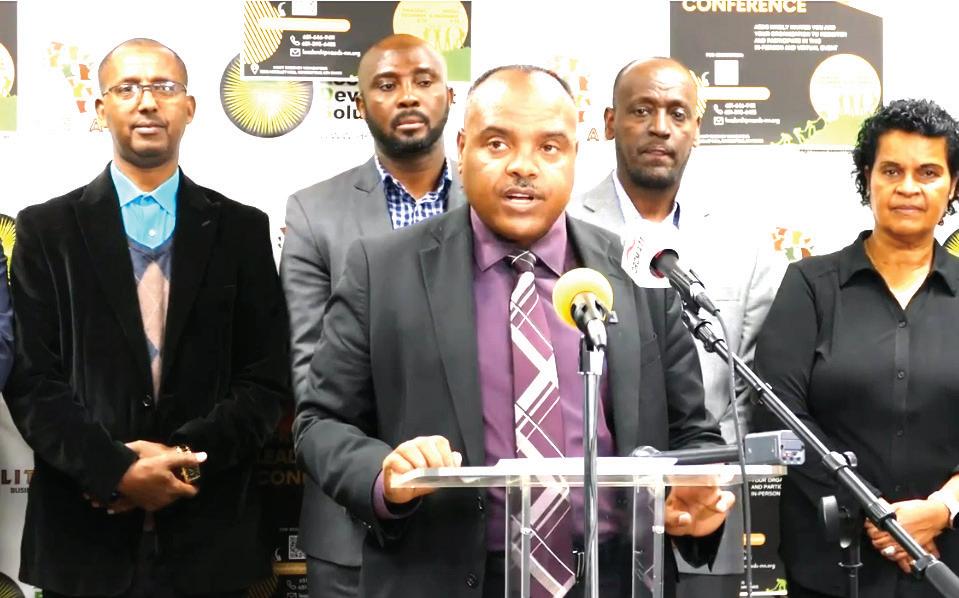
A celebration was held Thursday evening Nov. 17 at the LifeSource building in North Minneapolis to recognize six local Black men who promote health and wellness in the Twin Cities area. Hue-MAN Partner ship, local advertising agency Russell/Herder, and LifeSource organized the event.
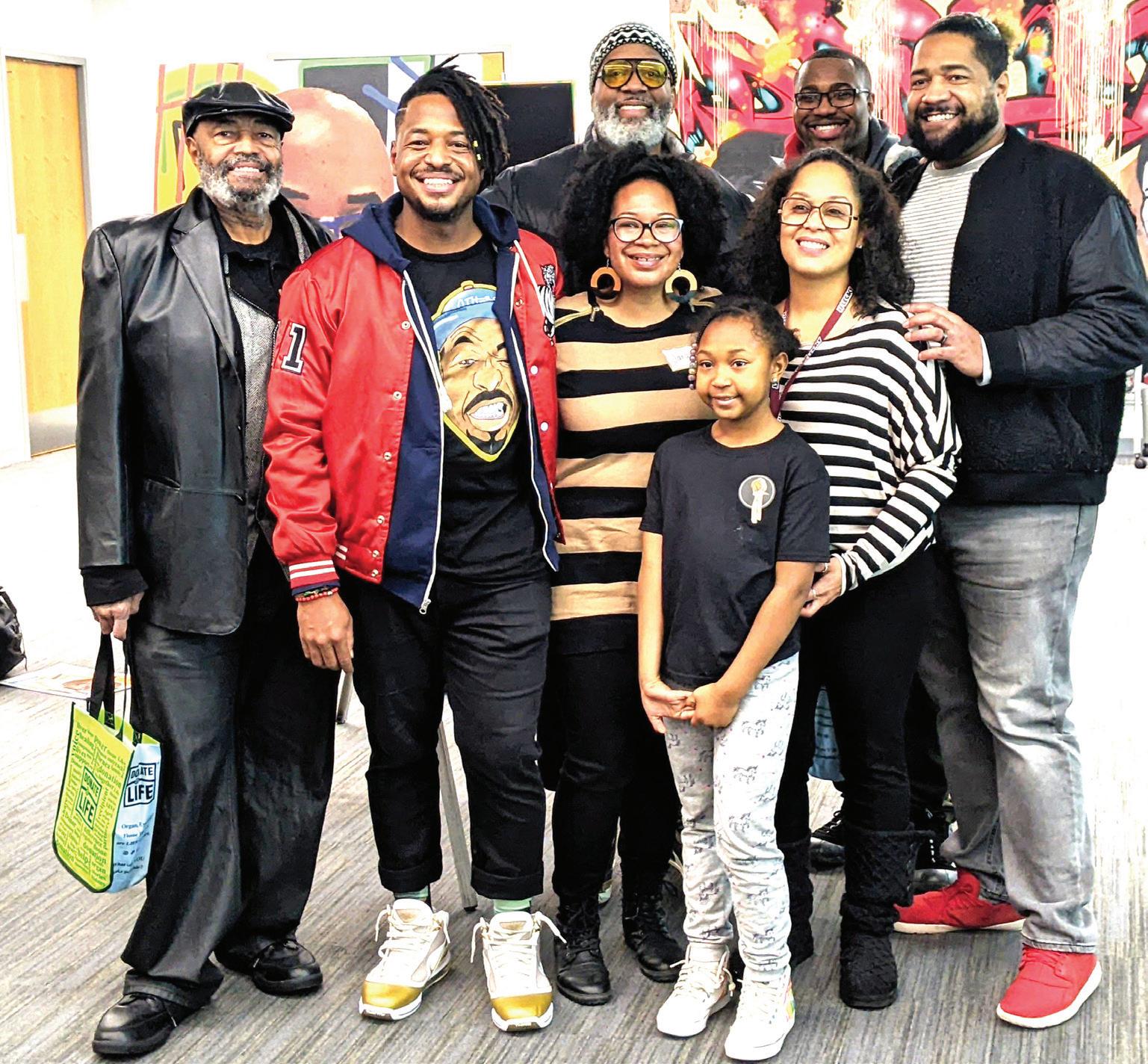
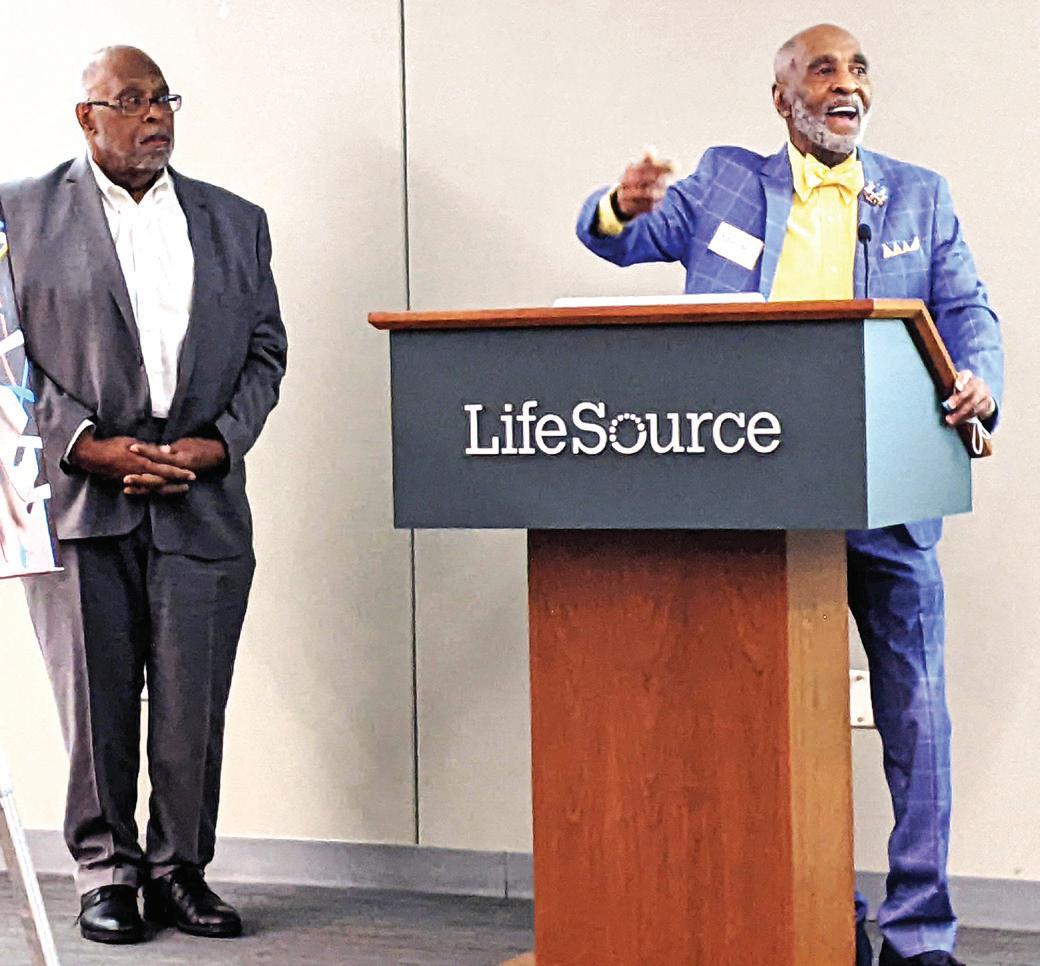
Clarence Jones, executive director of Hue-MAN, said they chose men who, after facing their own health issues, decided to dedicate their time to educating the community on how to lead healthier lives.
“These men usually don’t get accolades, or they don’t get credit, or they won’t be recog nized,” Jones said. “We wanted to give them a classy reception.”
The idea for the reception came about in focus groups made up of local community members gathered by Russell/ Herder. The Minnesota Depart ment of Health contracted the firm to help raise awareness of heart disease and diabetes in communities of color. Brian Herder, CEO of Russell/Herder, called the focus groups “deeply collaborative.”
“The thing I love most is it wasn’t a bunch of people sitting around at an ad agency coming up with ideas and launching them into the community like
we had any idea,” Herder said.
Augustine “Willie” Domin guez was one of the honorees for his community work with Hue-MAN and Parents in Com munity Action.
“In our communities of color, especially, we don’t know the avenues—we don’t get the pre sentations, information, educa tion,” Dominguez said. “We like to stay in our lane, but it’s time to get out there and let folks know that we’re here for them as well as they’re here for myself.”
The other five men honored were Kevin Jenkins, author of “Victory Over Kidney Dis ease”; Fred Evans, who runs

the Clipper Clinic, which gives free checkups for men in underserved communities; Jack Strawder, who works as an outreach specialist for Father’s Project; the late Bruce Hardway, for his focus on a low-stress lifestyle; and Chuck Thomas, who founded Every Day is Room 4 Improvement and It’s Just Water.
Thomas passed away on Nov. 14 before being able to accept his award. Chris Petersen, a professor from his time at the University of Minnesota who helped him found It’s Just Water, spoke about Thomas’s work.
“He will be remembered
fondly as a player—not just for himself but the voice of others,” Petersen said. “He had a quick wit and a good sense of humor.”
Petersen said she would con tinue Thomas’s work in his pass ing. She noted that the death of Thomas, who lost his eyesight and a kidney to diabetes, died on World Diabetes Day.

All six honorees of the night
Has Black Friday lost its luster?
By Stacy M. Brown
According to a survey conducted in October, nearly 70% of consumers plan to skip Black Friday and holiday shopping altogether this year. While some believed retailers manipulated shoppers, a relatively large amount (18%) said they won’t shop because of large crowds.
Despite the relatively small sample size in the survey, a growing number of shoppers said Black Friday had lost its appeal. “While Black Friday sales provide a great opportunity for brands to keep customers coming back for
more, it also presents noteworthy risks for shoppers around buying too much,” said Michael Podolsky, CEO and co-founder of PissedConsumer. com, which conducted the survey.
“Consumers are now savvier with their purchases and how much they spend. That is not just inflation caus ing the shift in consumer behavior,” Podolsky stated. “The survey revealed that 85% of shoppers now rely on online reviews when buying as they intend to avoid general unhappiness with shopping.”
Small business growth expert Stephanie Scheller of Grow Disrupt
said there’s little question that the days of getting excited about the day after Thanksgiving shopping sprees have ended. “While there are still ‘doorbusters’ at some places that are worth participating in, most places offer great deals online or are starting so early that it’s not worth the fight for Black Friday beyond tradition,” Schell er offered.
“I think that the problem with this is that we’ll end up diluting the power of the concept, and while overall shop ping numbers might be okay, the onepowerful-day for generating sales for
had a portrait painted of them by local Black artist Benny Rob erts. Roberts met Herder at one of the focus groups and was commissioned for the portraits as soon as the idea for the ban quets was finalized.
“I stand on the shoulder of giants,” Roberts said. “As the next generation of Black lead ership in our community, it was
an honor to do this work to represent men that have laid a pathway that I get to walk on, and I’m very grateful for all of those things.
“Black men deserve to grow old. It’s almost like there’s an epidemic against us that robs us from being able to live long lives, and so many systemic
PRST STD U.S.POSTAGE PAID TWIN CITIES MN PERMIT NO. 6391 THE VOICE OF BLACK MINNESOTA SINCE 1934 November 24 - 30, 2022 Vol. 89 No. 17 www.spokesman-recorder.com Phone: 612-827-4021 Read about fall jazz favorites on Page 6. Inside this Edition... To Subscribe Scan Here
See NORTHSIDE on page 5
■ See EDUCATORS on page 5 ■ See SALES on page 5
Artist Benny Roberts (in red jacket) with family
Honoree Kevin Jenkins speaking at the gathering as Clarence Jones looks on Photos by Cole Miska
Gene Gelgelu speaks at a Nov. 2 press conference.
Photo courtesy of AEDS
Leaders and community members at the V3 groundbreaking Courtesy of Facebook/Mayor Jacob Frey
of NNPA
Photo
courtesy
Metro
Collaborative advances Black health and welfare
By Angela Rose Myers Contributing Writer
un violence has become a top public health issue in the Black community, and Black women are stepping up to the plate to address it and other social determinants of health that have made Black Americans more susceptible to preventable illness es and a shortened lifespan.
Shanasha Whitson is a pub lic health expert who is one such individual. Whitson start ed the Community Partnership Collaborative (CPC) 2.0 to help address public health issues. While providing direct services in the Black community in Min nesota, CPC LLC also helps other organizations build out their capacity in order to create a sustainable network of Blackled organizations to address the community’s needs Today, the Community Part nership Collaborative 2.0 does tailor-made case management for those who have been di rectly or indirectly impacted by gun violence. The organiza tion houses Mothers Against Gun Violence, a community advocacy organization that is known as a boots-on-theground frontline group provid
ing services to those impacted by gun violence.
These wrap-around servic es include life coaching case management that can help individuals get housing, find employment, get health insur ance, and whatever other help they may need. Whitson start ed the group when her son, while in college, was held hos tage and robbed at gunpoint at a New Year’s Eve party.
In her work with mothers, Whitson said, “This is a violence intervention and prevention program that gets young men and women in a circle of support to abate gun violence and give them skills and tools that they need to do any number of things.”
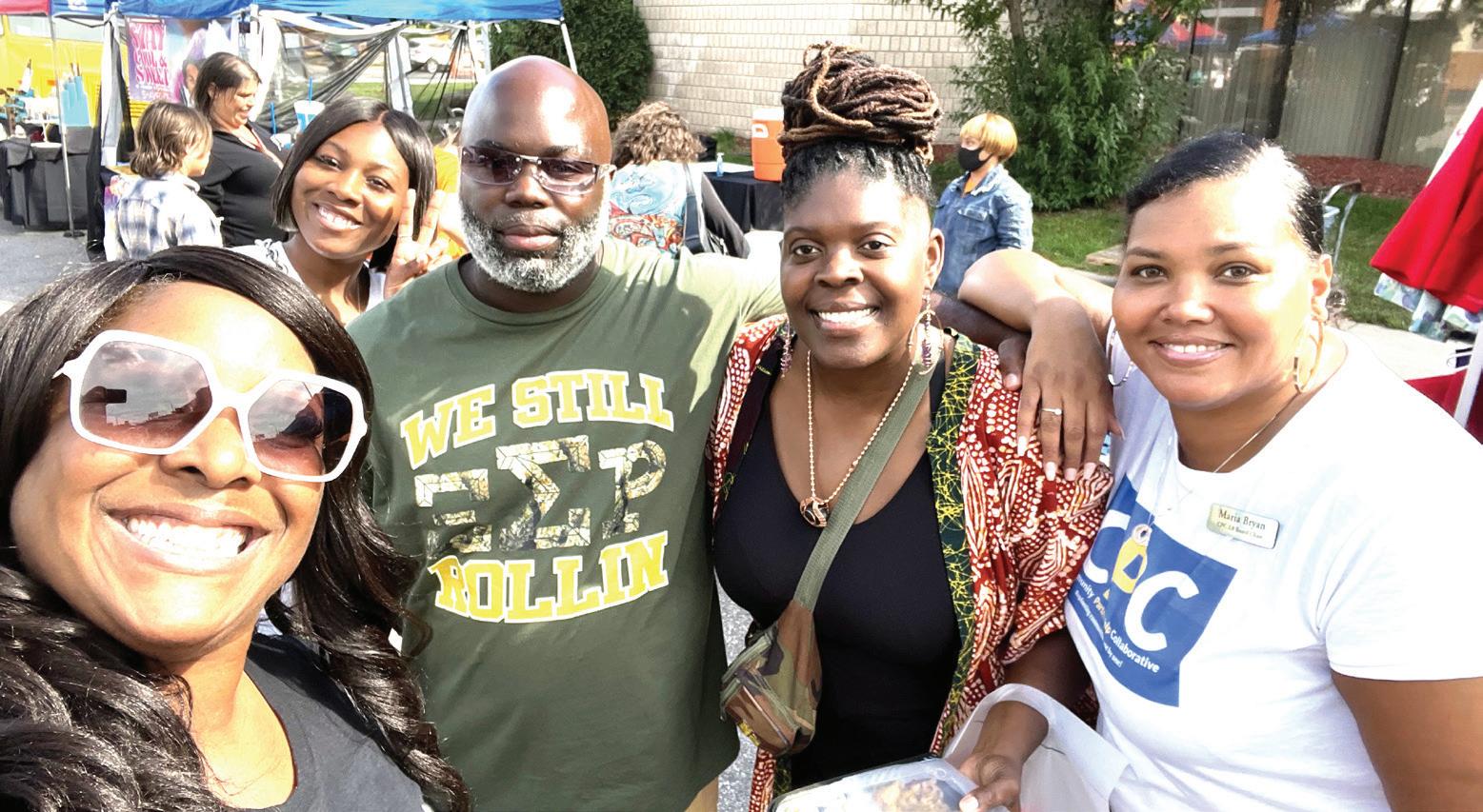
The organization was started in the community by community. While attending a community meeting held by Rev. Alfred Babbington-John son of the Stairstep Founda tion, Whitson met Dr. Olihe Okoro, a pharmacy professor at the University of Minnesota Duluth, who inspired her to apply for public health grants.
Whitson already was a pub lic health expert looking for more opportunities and fund ing to do her work in the Black community. She was shocked
that there were so many op portunities to address public health issues.
As Whitson said in an inter view with the MSR, “The crux of a lot of the work that we do at CPC 2.0 is helping improve the social determinants of health for the Black commu nity. [After meeting Okoro], I got hired to do some research for the University of Minne sota Duluth, and Dr. Okoro said, ‘You know, there are a lot of grants out there through
Driver shortage forces more Metro Transit service cuts
By H. Jiahong Pan Contributing Writer
Metro Transit is once again cutting service due to a lack of drivers. The changes include an 8% service reduction and involve suspending branches or reducing service to run as frequently as once every two hours. This will mostly affect routes serving St. Paul and take effect on Dec. 3.
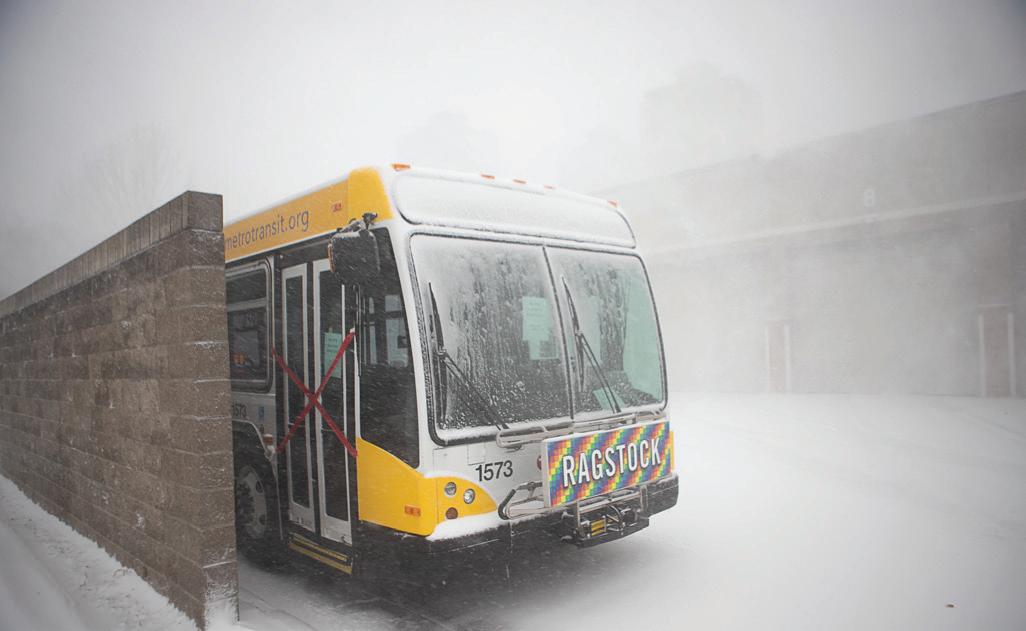
This follows several rounds of cuts Metro Transit made over the past year, all because it is short of drivers. In Octo ber, Amina Wolf, the agency’s interim deputy director of Ga rage Operations said they are losing 16 drivers per month.
Even though the agency got the word out earlier than usual, riders expressed surprise and displeasure. “I didn’t know about the cuts,” said Herman Porter as he rode the 852, an express route that runs be tween Minneapolis and Anoka.
Porter rides the 852 every day to visit friends and work an on-call maintenance job. Start ing in December, the 852 will be reduced to run anywhere
between every hour during rush hours on weekdays to ev ery two hours and 45 minutes on Saturdays. Service on Sat urdays will start one hour later, while service Monday through Saturday will end up to two hours earlier.
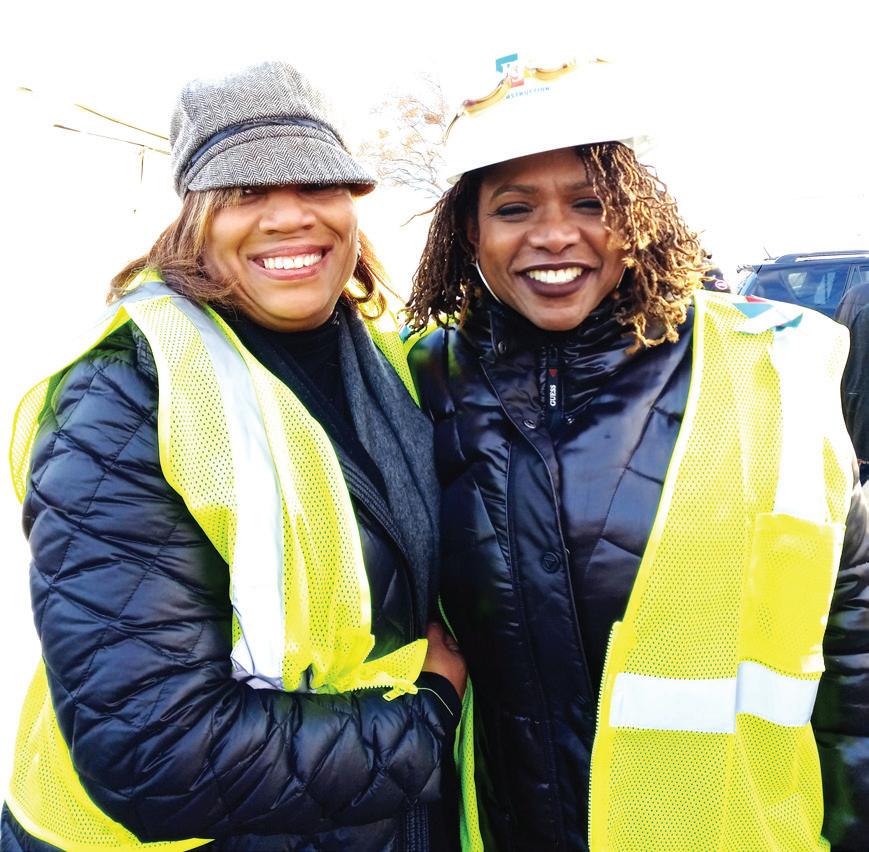
“I don’t have any way home if they make the cuts,” said Porter.
Jessie Bell, who commutes from Minneapolis to work as a caregiver in Shoreview, will also be affected, as Metro Transit will eliminate the 4:13 pm Route 62 departure from Shoreview that she rides on her way home.
“That’s gonna be a long walk coming from work,” said Bell
on her Route 62 ride home.
“[The 62] already comes at a funky time anyway. They’re really jacking it up over here.”
Metro Transit will also run the 62 less often, from every 15 minutes between Larpenteur and downtown St. Paul to ev ery 30 minutes.
The agency says they’ve tried many ways to hire drivers amid a 1.9% unemployment rate and concerns about working condi tions, which include working split shifts and risking assault by frustrated riders.
“[We are] doing everything we can to reach [BIPOC] com munities through creative mar keting tactics and removing any
Photo of the Week
CDC, NIH, the World Health Organization, that ask us, as researchers, to have commu nity partners. You’re not a non profit, yet you’ve been doing a lot of this work, like forever.’
“So, I wasn’t thinking about nonprofit work because I was already doing the work. She said, ‘You should turn into a nonprofit agency.’ And she sent me this grant that we couldn’t apply for because I didn’t have a 501(c)3. I couldn’t apply.”
“[The grant] was to help support a woman’s health dis parities, and I was so blown back that I couldn’t apply. And that’s what made me start CPC 2.0 in 2017, and we be came a 501(c)3 and started getting grants.”
When discussing the hurdles of being a 501(c)3, Whitson stated, “I run into so many organizations, they’ve got a 501(c)3, they paid this
lawyer, you know, $2,000$3,000, and now they want to apply for a grant.
“They don’t have a DUNS number They don’t have a Swift number. Not only that, but they don’t have a Sam’s
The work that CPC 2.0 and CPC LLC does comes with the understanding that Black health and welfare are deeply tied to making sure everyone in our community gets the ser vices that they need.
At the end of our conver sation, Whitson made one final call to action, saying, “I would just want to empha size CPC 2.0 provides mental health diagnostic assessments to the community so that they can get connected to mental health services. And our navi gators have access to helping people get health insurance.

“This is Minnesota. We have one of the best healthcare sys tems in the country. And so, we want to make sure every body’s healthy. So, come get health insurance! It doesn’t cost anything [to sign up]. It’s free of charge.”
She added, “In our commu nities, you got to be mentally healthy and physically healthy. In order to, you know, live, you have got to live your best life. So, we want to help people reach that goal.”

number [business identifier numbers]. Like they don’t have those intricate infrastructure pieces that you need to run any business, whether it’s a for-profit or nonprofit.”
CPC LLC works with these organizations to help them over
For more info about CPC 2.0, visit cpcmn.org.
Myers welcomes reader responses to amyers@spokesman-recorder.com. Courtesy of CPC 2.0

2 November 24 - 30, 2022 spokesman-recorder.com
come barriers. Whitson takes the knowledge that she has ac quired in her years of running a nonprofit, coupled with her graduate studies work, to help others, building a social network to address the issues prevalent in the Black community.
Angela Rose
(l-r) Shanasha Whitson, executive director, Chanelle McDavid, youth and community entre preneur board chair, Armel Green, arts and culture board chair, Ayolanda Evans of Black Family Blueprint, and Maria Bryan, CPC community voice board chair Courtesy of CPC 2.0
In order to, you know, live, you have got to live your best life.
“I don’t have any way home if they make the cuts.”
Braving the cold to break new ground
(l-r) Chanda Smith Baker of the Minneapolis Foundaton and Sondra Samuels of North side Achievement Zone strike a pose at the V3 Community Center groundbreaking at 701 Plymouth Ave. in North Minne apolis. (See the front page for the story).
Do you have a photo you’d like to share with other MSR readers? Send it to submissions@spokes man-recorder.com. Make sure to place “Photo of the week” in the email subject field. If your photo is selected, you will win a one-year subscription to the MSR newspaper. ■ See Transit
Photo by Nikki Love
on page 9
By Dr. Alyse Hamilton Guest Contributor


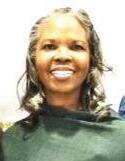
When asked, many of us are not quite sure what “healthy” really means. Many doctors may tell you that if you do not have any symptoms you must be healthy. But, not so fast. A person can be free of symp toms and only minutes away from a deadly heart attack or diabetes or even cancer.

Healthy is not what happens at a doctor’s visit. It is what happens before and after the visits. Healthy happens when our bodies are in balance physi cally, mentally and spiritually.
I tell my patients one of the most important systems in a human is the immune system. When it’s powerful, as it is in most children, almost nothing can harm us.

To be healthy, there are three important areas to focus on:
• What we put in our mouths
• What we put in our minds
• What we put in our souls
Bad foods, negative stress ful thoughts, and even nega tive beliefs can all tear down our immune systems and our health.
Health
Our health is not a right—it is our responsibility
What we put in our mouths
Bad carbohydrates, bad sugars and fried foods may taste great, but they are the devil in disguise when it comes to our health.
Bad carbs are found in foods made with lots of pro cessed white flour, starches and sugars. They are addictive and lead to obesity, which in turn leads to diabetes, heart disease, and even cancer.
According to the Centers for Disease Control and Pre vention (CDC), as a people, we African Americans tend to be far more obese than Hispanics, Asians and Caucasians. Don’t be fooled. The major cause of obesity is our diets.
too. Those are carbs with good fiber in them. For those, eat: ba nanas, buckwheat, oats, sweet potatoes, quinoa, blueberries, apples and red kidney beans.
The immune system depends on lots of healthy foods to run properly, like lots of good veg gies and some fruit. Daily, we need lots of vitamin C. My pa tients easily get 2,000 mg to 4,000 mg of vitamin C daily.
Did you know that oranges actually have very little vita min C? Try red and green bell peppers or kiwi fruits for more vitamin C.
Other vital nutrients for our immune systems are vi tamin E, zinc, magnesium and selenium. Daily.
And try to avoid fried foods, another death trap that afflicts far too many Black families. Most cooking oils are highly inflammatory inside us, and when heated break down into health-killing, cancer-causing acrylamides. And forget mar garine. It’s another health killer.
choose to do, move your arms and legs and breathe!
What about mental health?
Research has clearly shown that how we think can change us inter nally. Whether we think positive or negative thoughts, our thoughts can change our body chemistry for the better or for the worse.
Choose wisely. Walking around all day with a grudge or loaded down with negative thoughts creates negative body chemistry, which leads to negative health.
And finally, spiritual health.
Neuroscientist Dr. Joseph Di Spenza, in his book “You Are the Placebo,” makes it clear that the re search overwhelmingly shows that what we believe is as powerful as what we do. Whatever spiritually feeds your soul is as important to your overall positive health as what you eat and what you think. This is why meditation and prayer have been proven to be powerful posi tives for being healthy.
In addition to a positive diet of whole foods, my brothers and I were physically active playing sports and always on the go. I was also taught by my parents that I was never a victim. The only person who could stand in the way of what I focused on was me. I was in control of my thoughts and my fate all the way through medi cal school and to this very day.
And as a family, like most American Black families back in the day, we went to church every Sunday. We lived our faith daily.
To this day, I attribute these wonderful gifts from my parents to being a healthy person. Physi cally. Mentally. And spiritually.
Remember that a person with health has a thousand wishes. But, a person without their health has only one. They want their health back.
It’s up to you to keep your self and your family healthy. It’s your responsibility.
Ever wander down the ce real aisle at the grocery store? No matter how much most of those boxes tell you they are healthy, I call that aisle the “val ley of death.” It is a bundle of bad carbohydrates and massive amounts of health-killing sugars. But there are good carbs,
Vitamin D is also critical for the immune system. We get it mostly from sunlight on our skin, and as people of color we need more exposure than light er-skinned people. To supple ment, take vitamin D daily, es pecially in winter months.

Creating a dementia-friendly home
Almost every part of a home can impact the quality of life for someone living with a de mentia-related illness and their family care partners—even seemingly cosmetic choices such as wall colors, furniture patterns, and dishware. As part of National Alzheimer’s Aware ness Month, the Alzheimer’s Foundation of America (AFA) is offering tips for creating a dementia-friendly home.
Through The Apartment—a full-scale model dementiafriendly residence—AFA shows different adaptations families can make to make their homes safer and more dementia-friendly.
“Most homes were not de signed with the needs of some one living with a dementia-re lated illness in mind, but virtually every aspect of a home can af fect the person’s quality of life,” said AFA President & CEO Charles J. Fuschillo, Jr.
“From purchasing higher-tech appliances all the way down to labeling dresser drawers and putting up old family photos, there are a variety of adapta tions family care partners can use to make their loved one’s home more dementia-friendly.”
Steps that families can take include:
• Being mindful of color choices and contrast. Colors can be used to help with mood. For example, blue often has a calming effect and is great to use in places that promote relaxation, such as lounge ar eas, bathrooms, and bedrooms. Brighter colors like red, purple, and orange can be energetic and stimulating, and, therefore may not be the best choice for use in these rooms.
• Color contrast is impor tant too. It aids with vision, depth perception, and spatial orientation. Dishware that con trasts with the tablecloth color makes it easier for someone with dementia to see the food on the plate.
• Providing visual cues. La
beling is an easy, low-cost ad aptation that anyone can make. For example, putting labels on dresser drawers with the name of the contents (i.e., shirts, pants, socks, etc.) and a small picture is an effective memory cueing technique.
• Choosing proper lighting Lighting obviously influences eyesight, but it can also affect the body and behavior. Blue light rays stimulate the brain, in crease alertness, and elevate en ergy levels, but also negatively impact sleep quality in the eve ning. Lights that produce glare may hinder vision for someone with dementia. Flickering lights can increase agitation.
• Glare-free lighting aids with sight, while lighting that operates with a circadian rhythm mimicking natural pat terns of high blue light in the day and low blue light at night can improve sleep and reduce agitation.
• Using reminiscent deco rations. Décor and photos can serve a purpose beyond mak ing a home aesthetically pleas ing—they can promote famil iarity, aid with mood and assist with memory recall. Beach/ nautical-themed pictures can promote positive memories for someone who enjoys the ocean. Vintage magazines on shelves and tables can help stimulate memory and remind the person about a familiar time period from their past.
Family photos reinforce the faces of cherished loved ones.
• Embracing technology.
Technological tools can provide additional support to care part ners, especially if they aren’t in the home with the individual living with a dementia-related illness. Interactive virtual as sistant technology can enable caregivers to schedule remind ers and events that will be audi bly played for a loved one, such as “it’s lunchtime now” or “time to take your medication.”
Care partners can utilize app-controlled thermostats to check, program and change the temperature remotely, as well as smart smoke and carbon monoxide alarms which can be programmed with friendly hu man voices and be controlled and monitored via an app.
Families can learn more about these and additional ways to create a dementiafriendly home by visiting The Apartment page on AFA’s website at www.alzfdn.org/ theapartment. The page in cludes a brief film tour along with The Apartment: A Guide to Creating a DementiaFriendly Home, a free 20-page booklet that showcases each of the rooms with detailed, step-by-step summaries of de mentia-friendly improvements that can be made. Individuals can also contact AFA’s Helpline 7 days a week by phone (866232-8484), webchat (www. alzfdn.org), or text message (646-586-5283).
Source: Alzheimer’s Founda
tion of America
If you must fry foods, use healthy organic butter or try avocado oil. It remains safe up to over 500 degrees.
And for physical health, don’t forget how important ex ercise is. We were created to move, not plop down in front of the TV. Find something physi cal you like to do, and just do it. Walk. Ride a bike. Go bowl ing. Go dancing. Whatever you
I was raised on a Navajo Indian reservation in Arizona. My dad was a teacher for the Bureau of Indian Affairs. We lived in government housing and had just enough to get by. But, we were always healthy.
My mom made sure we ate wholesome foods with proteins and lots of good vegetables. Pro cessed or fast foods loaded with chemicals and bad carbohydrates were not on our menu at home.
Dr. Alyse Hamilton is the found er and medical director of the Ad vanced Health and Vitality Center in Edina, Minnesota. Dr. Hamilton offers her patients positive results from her exceptional professional training and an extraordinary pas sion to provide safe, proven and ef fective treatments for adrenal insuf ficiency, thyroid disorders, chronic fatigue and pain, menopause, an dropause (male menopause), fibro myalgia and age-related conditions.
November 24 - 30, 2022 3 spokesman-recorder.com
Our
As we spend more time indoors, here are some important reminders: GET VACCINATED For more information, visit northpointhealth.org/covid Scan this QR code for more vaccine information FOLLOW VACCINATION GUIDELINES GET VACCINATED IN PUBLIC INDOOR SPACES WEAR A MASK IF YOU HAVE SYMPTOMS OR EXPOSURE TEST YOURSELF
thoughts can change
our
body chemistry for the better or for the worse.
Curb your holiday shopping habits with these tips
When it comes to holiday spending, it’s easy to get car ried away. After all, what could be more fun than vacationing, opening presents, and spend ing time with loved ones? That said, it’s essential to ensure you focus on the things that matter most rather than over spending on frivolities.

To help you keep your spend ing in check, here are some thrifty tips to keep you from blowing your holiday budget.
Create a holiday budget
Start by creating a realistic budget if you’re worried about going overboard on decora tions, party favors, or gifts this year. Decide on how much money you want to spend on each area (travel, food, holi day cards, gifts, etc.), and then stick to that amount.
Don’t forget to factor in unexpected expenses, like gas for out-of-town trips, pet care costs, and gift wrap. Once you’ve determined your bud get, set up a cash envelope sys tem for your holiday purchases to help you stay on track.
Make a gift list
Once you know how much you can afford to spend, list the people you plan to buy gifts for and set a budget for each. If the list seems too long, try scaling back so you can fit it into your budget.
Consider making something homemade if you cannot cut a few names off the list. Ex
amples include fresh-baked cookies (or a cookie mix gift sack), mason jar snow globes, or hand-painted ornaments.
Clip coupons
Gone are the days of sifting through newspapers for sales and discounts. These days, you can find coupon codes online for everything from gifts to your travel accommodations.
Shopping apps such as Re tailMeNot and CouponCabin make it easy to clip and save your favorite coupons, so you can access them right on your phone when shopping.

You can also sign up for re ward programs like Amazon Prime and ShopRunner to score free shipping and other perks with your online orders. Pro tip: create an email ad dress for online shopping, so you don’t get overwhelmed with promotional emails. This way, you’ll be able to reap the benefits of signing up while still keeping your inbox clutter-free.
Send e-cards
If money is tight this year, skip the expensive greeting cards and send your holiday
greetings via email instead. (Don’t worry, you don’t need to be tech-savvy to do it!)
Hundreds of websites out there will help you create cus tomized holiday cards in min
PRO TIP:
utes. A few examples include Canva, Smilebox, Ecard Shack, and Punchbowl.
E-cards aren’t just cost-ef fective and more eco-friendly than traditional holiday cards. Best of all, you can share them with friends and family with out spending excessively on postage.
Host a potluck
Can’t swing the cost of throwing a big holiday bash this season? Why not host a potluck instead?
Potluck dinners are a great way to celebrate the holiday season with friends and fam ily without breaking the bank. Plus, they eliminate the stress and hassle of cooking a huge meal at home (and cleaning up the mess!).
If you’re worried about food allergies or picky eaters, create a menu ahead of time, so your guests know what to bring. And if you’re plan ning a themed party, consider asking your guests to wear festive attire (ugly sweaters, holiday characters, etc.) to add to the fun.
The holidays bring laughter and cheer. But for many, this jolly season can cause anxiety and stress, especially for those on a tight budget. By following these tips, you can avoid stress and enjoy the celebrations with family and friends without wor rying about your wallet.
Health insurance that fits my budget?
I’m covered.

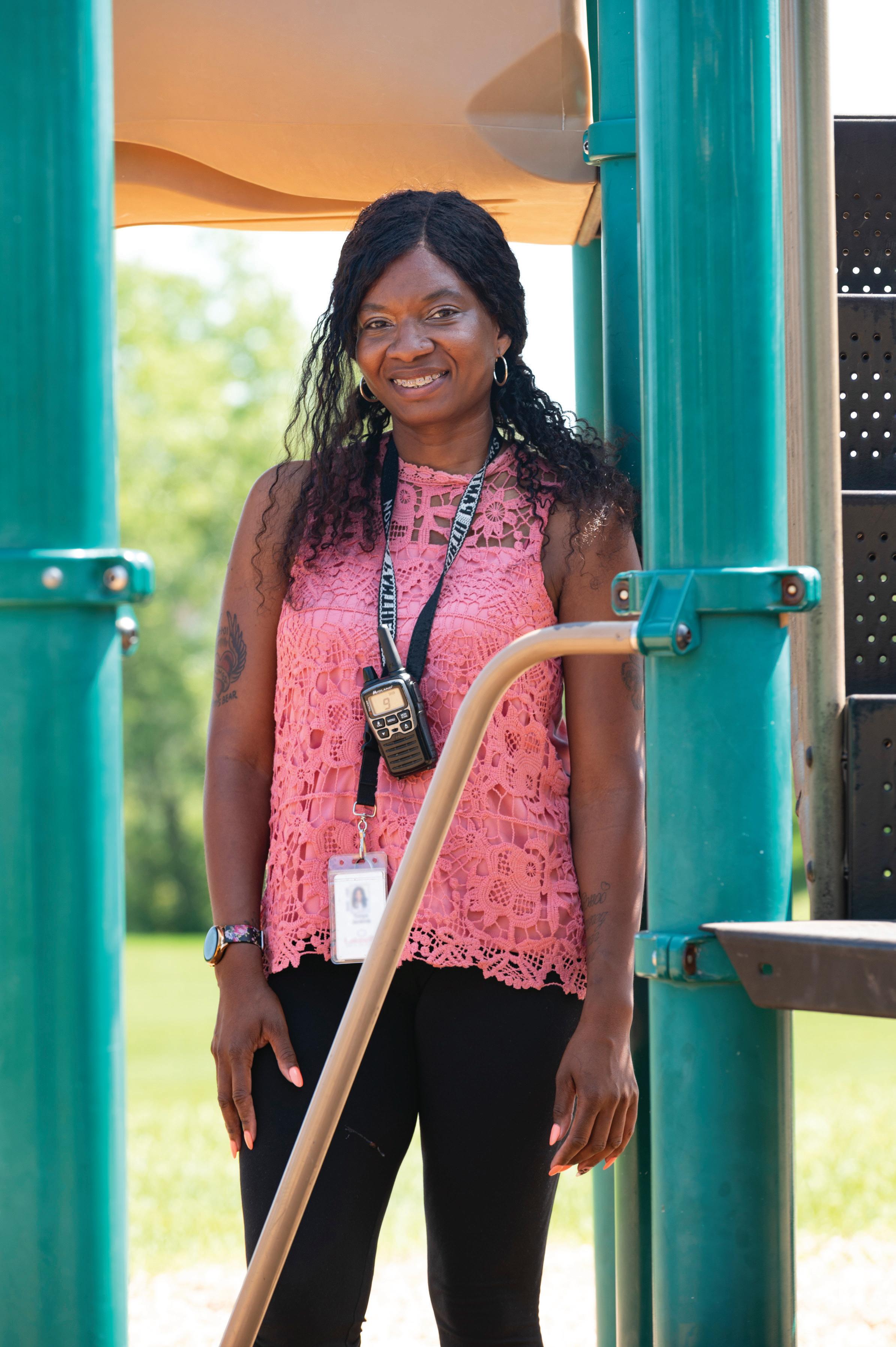
MNsure helped me save money on my health insurance.
Find free help at mnsure.org
“Keep the Vision Clear.”
A vision board can have a profound impact on your life. It can influence your personal life, business life, spiritual life and other areas. I want to share with you how to create an effec tive vision board.
Vision boards are often seen as an arts and crafts project involving glue sticks, scissors, magazine cut-outs, and printed pictures. But they can be so much more than this: They are a visual manifestation of the life you want to have. They display what you want out of your time on this earth and what your innermost desires are calling you to accomplish. There may be no other tool that can get you closer to fulfilling your idea of a perfect life than this tangible guide to the future.
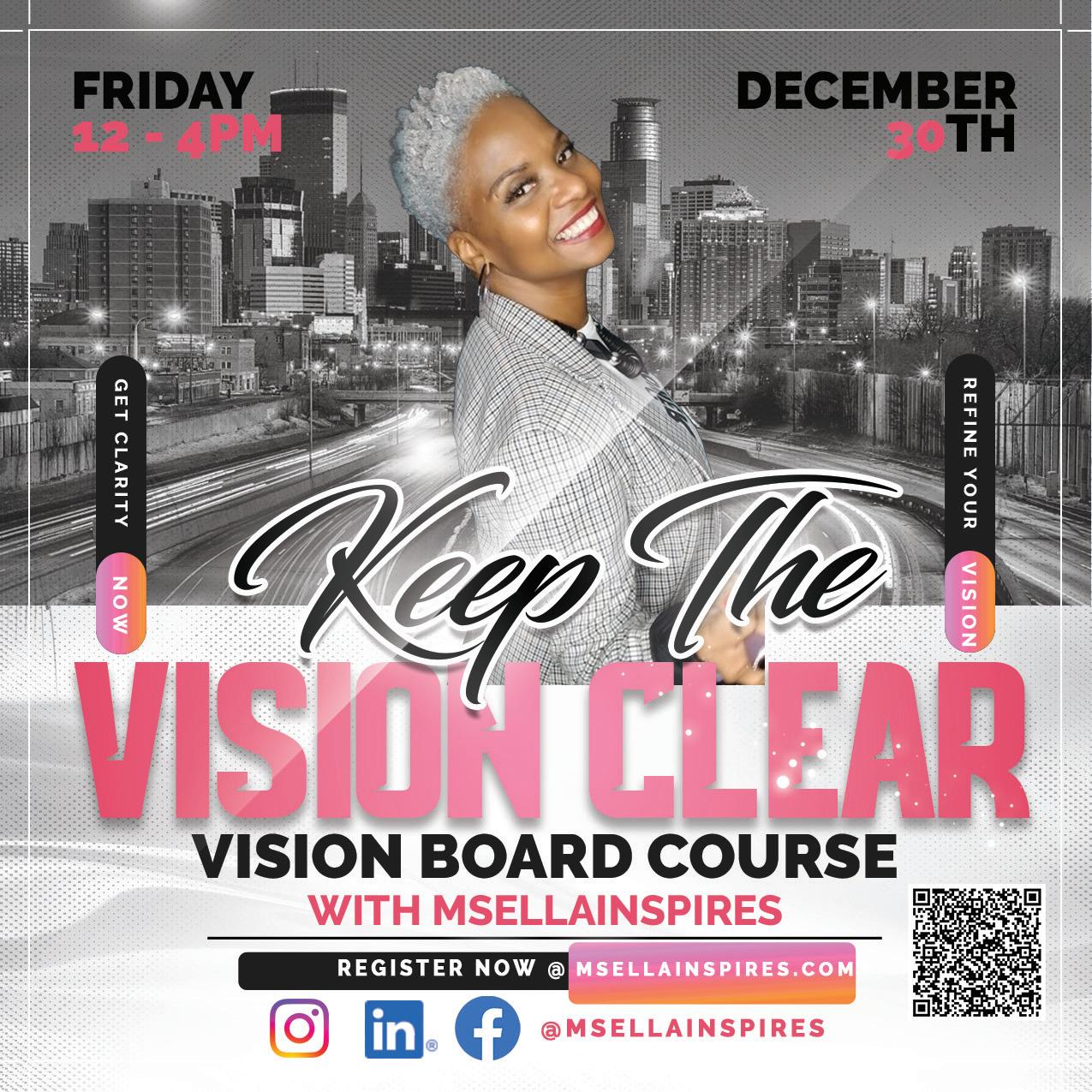
4 November 24 - 30, 2022 spokesman-recorder.com
With gratitude, Coach Ella,
Business
Source: JP Morgan
Photo: standrets via 123RF
promotional
Create an email address for online shopping, so you don’t get overwhelmed with
emails.
The gathering aims to “amplify African immigrant voices and facilitate mean ingful dialogue among multisector African immigrant leaders about our communities’ challenges, opportuni ties, and contributions across the US and internationally” as stated by AEDS in their press release about the two-day event.
AEDS started in 2008 as a plat form to help small businesses owned by African immigrants to gain access to financial and technical resources. It provides several services such as educational workshops and technical assistance in the areas of accounting, legal issues, and marketing.
AEDS also provides entrepreneurs with business loans of up to $100,000 for existing businesses to expand and up to $25,000 for new businesses on their launch.
The lending organization was founded by Gene Gelgelu who now serves as its president and CEO. Gel gelu, who is from Ethiopia, banded together with other immigrant busi ness owners after having realized the economic disparities that they were facing came from language and cul tural barriers.
Instead of navigating the financial landscape alone, Gelgelu and his peers
NorthSiDE
Continued from page 1
health-based kitchen/café.
It is promoted as more than a fancy rec center but “a beacon of hope…a focal point bridging the Northside to Downtown [Minneapolis]…a hub for the community to gather and grow together,” declares the V3 Cen ter website.
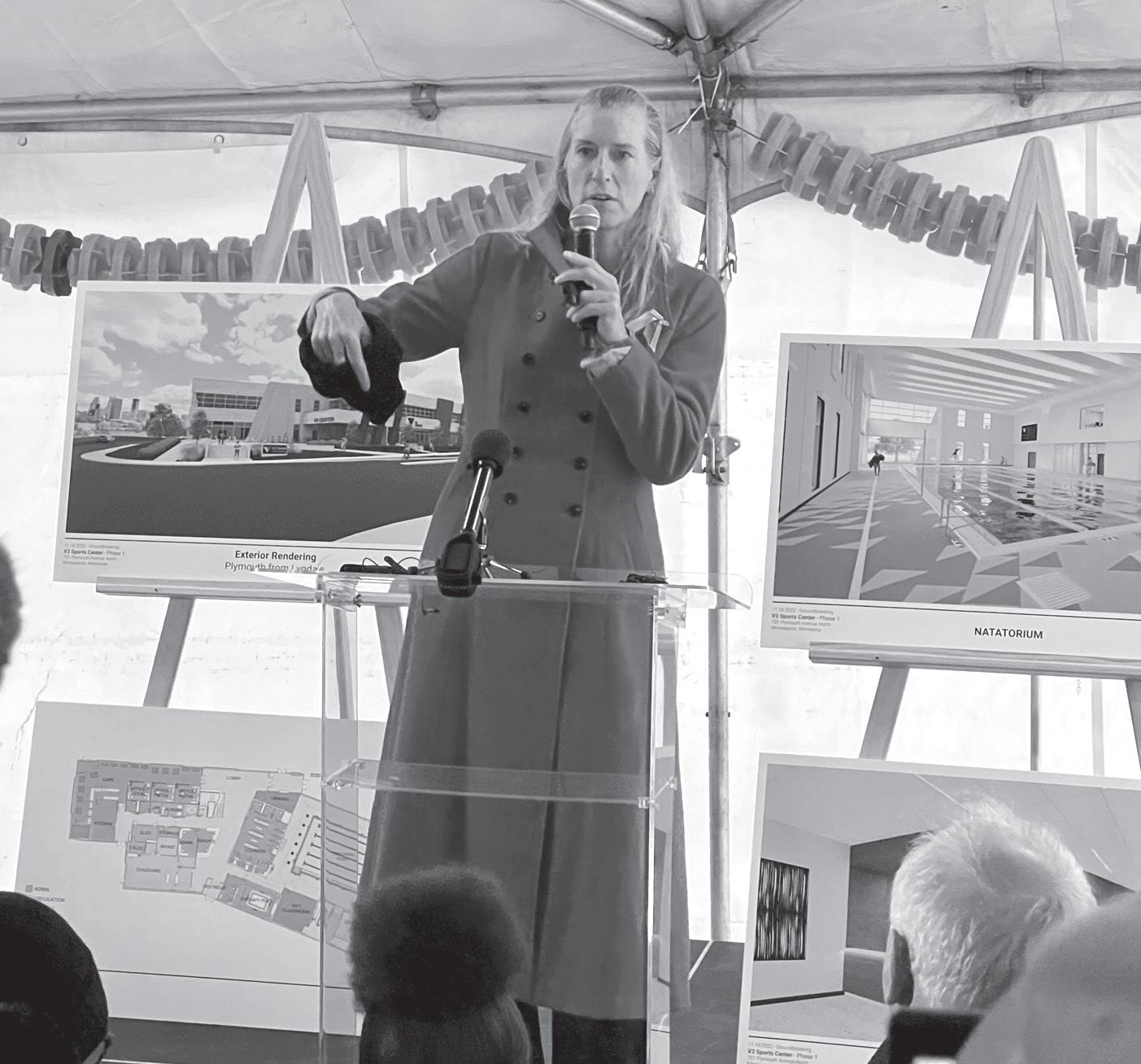
Minnesota Governor Tim Walz told the gathering, “Watch ing a community come together, watching a vision, watching us talk about a physical space with the capacity for us to transform an entire area is so inspiring.”
The newly reelected governor was among several elected offi cials on hand who took part in the ceremonial groundbreaking amidst frigid temperatures.
Afterwards Walz told the MSR that his administration fully supports the new center, “an opportunity to have a world class facility for our children” in North Minneapolis.
In December 2020, V3 Sports received an anonymous $4 mil lion donation with a promise to match it if the organization can raise $4 million in additional community donations. Walz told the MSR he plans to submit a funding request during the next legislative session:
“I put a request in last year in our bonding bill, and we’ll cer
EDuc AtorS
Continued from page 1
came together to form AEDS to help those facing what they once had to tra verse alone. Now clients of AEDS can not only receive funding for their busi nesses but also access homeownership education and business coaching.
Now, after 14 years, AEDS has sup ported thousands of entrepreneurs, according to Gelgelu, when just 20 years ago there were only a handful of African-owned businesses.
“Long time ago, when you came here and we had very few, actually one or two restaurants on Riverside,” he said. “Now, today, that’s not the story.
“Just in St. Paul, we have so many restaurants. In Minneapolis, we have so many restaurants. Brooklyn Park and Brooklyn Center, in a different part of the state…even including in the suburbs.”
Tsegaye Gelgelu is the community building and special projects manager at AEDS. He describes how the orga nization reflects the diaspora that is represented in the Twin Cities. “We have a Ugandan employee, we have a Liberian employee, we have Ethiopi ans. We have a Somali guy. So, we are providing culture-specific services for our communities,” he said.
AEDS has supported a wide range of businesses including restaurants, home health care, and transportation, all of which have had an impact on the state. A 2015 study published by Dr. Bruce Corrie of Concordia University found that African immigrant business
owners in Minnesota generated over $1.6 billion in income purchasing power each year. Through the support of organizations like AEDS, Gelgelu believes that this can increase.
Beko Tufa is one of the many busi ness owners who have walked through the doors of AEDS to receive business support. She operates the Ethiopian
ebrated 10 years of business this past June and looks to partner with AEDS as it expands.
This growth and positive impact on businesses over the years was not enough to stave off the financial meteor that cratered the Twin Cities in 2020. While many businesses were impacted by the pandemic, the Twin
African immigrant business owners negatively affected by the pandemic and civil uprisings. They also helped distribute millions of dollars in state and federal funds for COVID relief.
With its first in-person event to take place next month, AEDS is plan ning to use the conference to uplift the African immigrant community in Minnesota and beyond to network and support one another in their shared entrepreneurial endeavors.
restaurant Dilla which is located in the Cedar-Riverside neighborhood. Like many of the entrepreneurs that AEDS assists, Tufa had already been oper ating her business, but needed help working out the logistics of permits to run it at full capacity.
“The first time I asked about them, the business [had been] open six months, maybe one year, I don’t remember. Somebody told me to go over there. I take the phone number, I call him, he made an appointment. I go there and they helped me with everything,” Tufa recalled. “Business license, liquor license—I remember being there for four hours to get me permits from the City of Minneapolis.”
AEDS also helped Tufa with financial loans, one of which was for $20,000 in contract work and another $100,000 to establish her second res taurant in St. Paul. Dilla recently cel
Cities saw many immigrant-owned businesses close due to the economic impact of COVID-19 along with the civil uprising that followed the murder of George Floyd.
Areas like Lake Street and Uni versity Avenue where many Africanowned businesses are located found themselves going out of business vir tually overnight. Seeing the damage done, Gelgelu and his staff launched a GoFundMe campaign to support affected businesses.
“We said we’re going to raise funds for those involved in the civil uprising,” he said. “We are not a grant-making organization, but we said, you know what, what we’re going to do is for the transparency. We’re gonna have a diverse group, African group, to set the criteria of who should receive the money.”
AEDS raised over $400,000 for
“The conference that we are going to hold is a means or a catalyst or a vehicle for galvanizing the African immigrant communities,” Tsegaye said. “We are also trying to bring together the Afri can immigrant communities and form some kind of network whereby their voices can be heard when approaching different policymakers.”
Gelgelu echoed this sentiment and explained that all are welcome to attend the conference, as many of these topics are related to many communities. “It’s about creating our own space where our folks can have a place to network and learn from each other and those networks of leaders across the U.S. We also have a very diverse panel of speakers, including those of Black heritage.”
For more info, visit www.africanleadershipconference.com.
Abdi Mohamed welcomes reader responses to amohamed@spokesmanrecorder.com.
development, a destination point in North Minneapolis, but it’s also for our children,” said Sen. Champion in a brief MSR interview after the ceremony. Like Walz, Champion also was reelected to the Minnesota Sen ate and elected Senate president, the first Black elected official in state history to hold the post.
“We can all agree that some thing needs to happen, but we need to come together and have a real plan around how do we address all of those disparities,” stated Champion.
tainly put that in again this year to make sure that we get the opportunity to play a part in this investment.”
The new center can “be seen in many other things,” said State Senator Bobby Joe Champion, whose District 59 includes the North Side and portions of downtown. He was the event emcee last week.
Champion later told the MSR, “I think it’s high time that people see that North Minneapolis is a great place to live, work and play. We need assets like this and other community jewels in order to make sure that we’re con stantly promoting that notion.”
The first phase of the con struction is led by firms that are owned by people of color: TRIConstruction and LSE Archi
tects are both Black-owned, and RJM Construction is based in Golden Valley.
“We’re super excited to be here,” proclaimed LSE Lead Architect Keon Blassingame. “As an architect who grew up in this community, it’s really great to
equity,” said Northside Achieve ment Zone President/CEO Son dra Samuels, “we really have to talk about love equity and love justice. What I’ve seen here is 120,000 square feet full of love justice for kids who have been so left behind and neglected.”
the installment of a 50-meter Olympic-style pool as well as multi-purpose courts.
Rucker told the gathering last week that the new center “will create a space for our young people and community mem bers that would address the inequities that continue to face [them]. They just need a chance to reach their full potential.”

“Whether it’s health, wealth, education, higher ed, you name it, I think that we have to do everything to be very inten tional and get beyond the sur face, and dig deep down and deal with the root causes of the places and spaces that we find ourselves.
things have been pinned against us and our ability to survive.”
Mary Manning, assistant commis sioner for the Health Improvement Bureau at the State Department of
see such a project that’s strong and supportive.”
RJM Project Manager Tatia na Murphy added, “I will speak as a Northsider, what this proj ect represents from the building side is to make sure that our community works on this proj ect. Jobs are going to be created.”
“When you talk about racial
Health, praised the ceremony. “This is fabulous, having people come together to encourage one another and to get people to work in com munity, to foster this type of ability to donate and realize just how important it is to give opportunity and life to one another,” Manning said, adding, “The Department of Health will be in part nership with this group for a long time to come.”
Nichole Salaam, diversity, equity,
Thanksgiving.
The spending represented a .63% decrease from 2020 when Black Friday sales raked in $14.13 billion in online sales.
the holiday season concept is likely to fade.”
According to Adobe Analyt ics, Black Friday 2021 raked in $14.04 billion in online sales, with $8.9 billion spent on Black Friday and $5.14 billion on
At the height of the corona virus pandemic in 2020, 100 million consumers shopped online, while in-person Black Friday shopping fell 37 per cent from 2019. “Digitalization has encouraged the growth of online stores, due to which spe
During a tour of the facility last winter, Malik Rucker told the MSR, “We haven’t seen this type of investment” and esti mated the total project costs at “about $60 million.” V3 Sports’ strategic partnerships and com munity engagement director also pointed out that the second phase of the project will include
and inclusion director at LifeSource, said they have been partnering with Hue-MAN for years. LifeSource and Hue-MAN have been running a “Barbershop Initiative” where the groups teach local barbers how to provide education on health and organ donation to their clients.
Salaam said many people in commu nities of color have a mistrust of the medical establishment, so barbers are a good way to reach people as
cial deals and offers remain no more exclusive,” said Matt Gill man, founder of SMB Compass.
“People prefer online stores more than regular stores, which affects Black Fridays. And this is because of the perks online stores offer at the same costs. So, along with the low prices, we can focus on providing a better shopping environment.”
Despite declining sales and enthusiasm from many corners
V3 Founder Erika L. Binger told the MSR after the cer emony, “We have to be really intentional about making sure that we have people to run the center who are actually mem bers of the community. So, we are being really intentional about that and we do need to build that out.”
“This project is a great oppor tunity not only for economic
they are trusted by clients.
Salaam mentioned that medical mistrust, along with a lack of educa tion and misconceptions about organ donation, cause the Black community to have a much lower organ donor rate than White communities, despite 60% of people on the organ waiting list being BIPOC.
Salaam says two of the most common misconceptions around organ donation that circulate in
of the nation, some still enjoy the tradition of leaving the din ner table early to stand in the long lines that often accom pany Black Friday sales.
“I usually think of shopping as therapy; therefore, I always look forward to Black Friday for the excellent prices,” said Sean Harris, managing editor at Family Destinations Guide, which provides information and reviews of resorts, hotels,
and global destinations.
“Whether that’s public safety, whether that’s educa tion, when we think in terms of disparities, whatever it is, we need to really make sure that we’re focusing on dig ging deep and coming up with viable solutions that will be life-changing and sustainable.”
Champion, Walz and many others believe that the V3 Sports project is a positive step in that direction. “These invest ments are long overdue,” said the governor.
communities of color are that doc tors do not work as hard to save the life of a donor, or that donated organs end up on the black market. She emphasized that neither of these are true.
For more on LifeSource, visit www.lifesource.org.

Cole Miska welcomes reader responses to cmiska@spokesman-recorder.com.
“Black Friday not only allows me to fill my closet with the newest styles at discount pric es, but it also makes it possible for me to find some excellent offers on electronics and books,” Harris exclaimed. Black Friday will never lose its appeal to me because I can obtain incredible electronics discounts online.
Emily Saunders, chief rev enue officer for eLuxury, noted
that Black Friday always loses its luster during an economic down turn, but she said she’s skeptical about whether those declines are permanent. “Brick-andmortar retail is fading, but Black Friday still has a strong heartbeat when economic times are good,” Saunders asserted.
M. Brown is the NNPA Newswire senior national correspondent.
November 24 - 30, 2022 5 spokesman-recorder.com
Charles Hallman welcomes reader responses to challman@ spokesman-recorder.com.
AEDS Continued
from page 1
“These investments are long overdue.”
V3
Founder Erika L. Binger
Stacy
V3 Community Director Malik Rucker
Photos courtesy of V3
SAlES Continued from page 1
“We are trying to bring together the African immigrant communities and form some kind of network.”
Arts & Culture
Fall favorites and new offerings
Herwig is special guest Randy Brecker with long-time “Latin Side” band colleagues pianist Bill O’Connell, reedman Craig Handy and the trumpet/flugel horn of Alex Sipiagin with the rhythm section of Luques Cur tis, Robby Ameen and Camila Molina.
“Boogie Stop Shuffle,” “Goodbye Pork Pie Hat,” “Duke
music of John Coltrane, Miles Davis, Joe Henderson, Wayne Shorter, Herbie Hancock and Horace Silver. Now that he’s turned to Charles Mingus, there’s a good chance he could earn even more Grammy glory.
By Robin James Contributing Writer

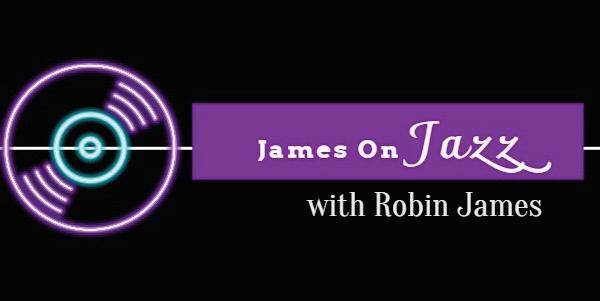
Although snow is here, we are still in fall and I’ve been thinking of my favorite version of the song “Autumn Leaves.”
I can’t help but think of sax ophonist Cannonball Adderly’s rendition with Miles Davis, Hank Jones, Sam Jones and Art Blakey. It’s the first song on Adderly’s album “Somethin’ Else.” That version is really one of the best versions that I’ve ever heard. If you’re looking for great jazz albums, this mas terpiece is it.
This fall season brings a great bounty of new jazz re leases and concerts to check out thus far. For example, from Savant Records there’s tenor saxophonist JD Allen’s album “Americana, Vol.2.”
Guitarist Charlie Hunter, bassist Gregg August, and drummer Rudy Royston are featured on this album. August and Royston are long-time col leagues with Hunter now join ing them. Allen says, “Charlie’s music brings light to me as a listener. When we met, we found out that we grew up in different areas of the country, but our experiences happen to
be very similar. That’s Ameri cana right there. I wanted that on this record.”
Also from Savant Records is the new release from trom bonist Conrad Herwig en titled, “Conrad Herwig: The Latin Side of Mingus.” Joining
Ellington’s Sound of Love,” and “Better Get Hit in Your Soul” are among the track list.
Herwig has received four Grammy nominations for his highly successful series of recordings that “latinize” the
Celebrating fall birthdays are a couple of my favorite jazz artists: pianist Vijay Iyer and vocalist Dianne Reeves. Both are coming to town soon. Iyer, whose birthday was Oct 26, performed at the Dakota on Nov 3. Over the years I’ve enjoyed his albums, “Solo” (Act Music), “Break Stuff” (ECM Records), and “In What Lan guage?” (Pi Records). The Da kota with its warm intimacy and all is the perfect place to hear him.
Reeves also celebrated her birthday on Oct 23. The 66-year-old is returning to the Twin Cities on Nov 30 at Or
The
22-year-old
Samara Joy,
Dakota
Records) and is getting plenty of praise from critics. Some think she sounds like a young Sarah Vaughan. I can hear that, too, but she’s definitely got a sound all her own.

Joy was a jazz winner at the first annual Jazz Music Awards presented Oct. 22 at the Cobb Energy Performing Arts Cen tre in Atlanta, Georgia. Visit the Jazz Music Awards web site for more information.
this past June. Expect soulful renditions of holiday classics, entertaining storytelling, and some swing for sure.
Joy’s new album is en titled “Linger Awhile” (Verve



Hopefully you’ll get the chance to enjoy these beauti ful late-autumn days by get ting cozy at home and listening to new albums or getting out and experiencing some good live jazz music. Either way, you can’t lose as there’s a lot to choose from so far this season.
Robin James welcomes read er responses to jamesonjazz@ spokesman-recorder.com.
6 November 24 - 30, 2022 spokesman-recorder.com
Samara Joy
Courtesy of Verve Records
chestra Hall for Big Band Holi days with the Jazz at Lincoln Center Orchestra.
concert features Reeves, a five-time Grammy winner, along with
emerging vocalist
who performed at the
This fall season brings a great bounty of new jazz releases and concerts to check out.
Using ‘race’ to challenge Native sovereignty
By Dr. Luke Tripp
The U.S. Supreme Court is pondering a case in which pro spective non-Indian adoptive parents and the State of Texas are challenging the Indian Child Welfare Act (ICWA). The ICWA (1978) sought to end generations of state policies that denied tribal sovereignty and forcibly removed Native children from their tribes.
The purpose of ICWA is to extend protections to children based on tribal citizenship, not racial status. However, au thorities routinely dismiss the requirement to treat “Indian” as a citizenship category.
Instead, they consider them a racial group, even though the law defines an “Indian child” not in racial terms but as someone with a membership in or who is eligible for mem bership in a federally recog nized tribe.
The ICWA requires that government actors treat “In dian” as a citizenship category whose boundaries are decided by self-governing Native na tions. It has been lauded as a powerful assertion of tribal self-determination.
Congress passed ICWA in response to sustained tribal activism. In the 1960s and 1970s, tribal activists placed Indian child removal practices under the public microscope. Congress, after extensive hearings, enacted the law to stop generations of racialized policies that forcibly removed 25% to 35% of American In dian children from their com munities, turning them over to White families and institutions for assimilation.
Agencies placed the chil dren in institutions or families with no tribal connections. American Indians asserted that
federal policy should honor the unique, sovereign status of tribes and ensure tribes could assume jurisdiction over child welfare cases involving their eligible members.
More than 500 Indian tribes see this case as a spearhead that could lead to other cases challenging Indian rights involv ing land, water, oil, mineral, and highly profitable gaming rights.
The court challenge
The State of Texas and sev eral White families are chal lenging the ICWA in court.
Texas asserts that the ICWA intrudes on state autonomy, and the families contend it is an unconstitutional racial clas sification.
American Indian tribes fought for the Indian Child Welfare Act to protect Indian parental rights, tribal rights, and tribal sovereignty.
A lawyer for the families ar gues that the ICWA categoriz es children based on whether the children are Indian or not Indian, and then it categorizes prospective parents based on whether they are Indian.
In Oct. 2018, Federal District Court Judge Reed O’Connor struck down parts of the law as unconstitutional, claiming that it mandated ra cial preference. In Dec. 2018, the United States Court of Ap peals for the Fifth Circuit or dered that O’Connor’s judg ment be stayed, holding that it violated tribal sovereignty.
On Aug. 9, 2019, the court
ruled that the law does not violate equal protection. On Nov. 7, 2019, the court voted to rehear the case. The ICWA remains in effect.
Tribes’ constitutional status Sociologist Hana Brown (2020) maintains that ICWA is a pivotal piece of federal In dian legislation. But she states that despite tribes’ constitu tional status as sovereign po litical entities, the U.S. govern ment interacted with tribes as domestic rather than foreign entities and engaged in cam paigns designed to decimate tribes and assimilate indig enous people.
To facilitate this work, she revealed that the U.S. gov ernment pursued campaigns characterizing American Indi ans as racial minorities with pathological cultures, relying on racial ideologies to justify urban relocation programs, the forced sterilization of Na tive women, and other enter prises designed to undermine, if not destroy, tribal sover eignty and to facilitate the federal government’s seizure of Native lands.
Indian child removal and ra cialization
Brown (2020) argues that Indian boarding schools and child removals were part of a broader effort by the U.S. to undermine tribal sovereignty and facilitate the seizure of in digenous resources.
She found that administra tive and juridical authorities routinely racialize American Indians and reconsolidate the racial order as they implement ICWA. State agents use the ra cial ideology that best serves their interests, not the inter ests of the racialized group, in deciding which populations constitute races or how to ra cially classify an individual.
She thinks that the con cepts “citizenship” and “race” both refer to political creations, designed to divide populations and justify the unequal distri bution of rights and resources.
I never had a conversation about money with my parents. Never. Even when I applied to colleges I don’t remember talking to my mother about the costs and how I would pay. We knew she couldn’t afford to help me pay college tuition.
I figured it out—I made it through four years of college with a combination of scholar ships, financial aid, and income from summer jobs. I went off to college without ever knowing what things cost, like the mort gage or a car note. I didn’t even know how to open a checking account. But I had to learn—fast.
Please don’t think I’m blam ing my parents or any Black parents for their lack of finan cial literacy or for not talking to their five children about money. It was almost taboo back then to discuss such things, even with children.
It still feels taboo today for many Black families. But if you are not sitting down with your children and talking to them about money, finances, and what things cost, you are mak ing a big mistake.
Let’s start with a couple of startling statistics.
• The average Black family has a net worth of $17,000, one-tenth of the average White family.
• Only 34% of Black Ameri cans own stocks compared to 61% of White Americans, according to the Federal Re serve’s last survey. Stocks and retirement plans are the primary ways Americans build
wealth, so that accounts for a big part of the racial wealth disparities.
• Only 44% of Black Ameri cans have retirement accounts with an average balance of $20,000 vs. 65% of White Americans who have an aver age balance of $50,000.
There are many reasons for these wealth disparities, and financial literacy only plays one part. Racism and discrimination have played a major role. But we must do a better job of preparing our children for a financial jour ney that we know will be difficult at best. And the best way to do that is to sit down with them and talk about money.
“There are many rea sons for these wealth disparities, and finan cial literacy only plays one part.”
The financial literacy gap begins early in life, according to The Annie E. Casey Founda tion’s report, Financial Literacy for Youth. “White and Asian 15-year-olds, on average, have substantially higher financial literacy scores, while Hispanic and Black students have sub stantially lower scores when compared to their general population peers, as reported in the 2020 U.S. National Strat egy for Financial Literacy.”
We know that some par ents need classes in financial literacy themselves. But the basics of financial literacy is understanding the basics of money. And for children that might include understanding
how much their parents earn, how much they pay for the mortgage or rent, what the gas and electric bill is, or what they pay monthly for those family cell phones. The more we talk to our children about money, the better they will un derstand life.
A friend who is a financial planner and who teaches fi nancial planning in an urban high school said he asked his class what things like cable television and utilities cost their parents, and they had no idea. Another friend who is an entrepreneur said not only did she know how much her moth er earned, but her mom also made her write out the checks to pay the bills. That way she knew there was nothing left at the end of the month.
You may not be able to talk to your children about stocks and bonds, but you can talk to them about money. And do what you can to ensure that they take advantage of the fi nancial literacy classes in high school or church.
If they learn about money, they will want to learn more. And the more they learn, the more they can teach their parents.
Rodney A. Brooks is a Texas metro news columnist and senior fellow at Prosperity Now. The au thor of “Fixing the Racial Wealth Gap: Racism and Discrimination Put Us Here, But This is How We Can Save Future Generations,” Brooks has written for USA TO DAY, The Washington Post, and National Geographic.
Medical care for MN prisoners is horrible
By Christopher Nelson
My name is Christopher Nel son, and I am a Minnesota pris oner. I have been for about 25 painful years.
Most prisoners in Minnesota suffer in many different ways— mentally, physically and spiritu ally—but when a prisoner has medical or mental issues or dis abilities the systematic neglect quickly becomes abusive.
When we try to seek medi cal care, reasonable modifica tions, or adaptive equipment for legitimate disabilities, we always run into staff who are very much prejudiced against prisoners in general, for what ever reasons.
It is an everyday occurrence if a prisoner needs anything from medication for heartburn to any kind of adaptive equipment, to go through a very abrasive and abusive medical staff while try ing to explain that we are still actually human beings with le gitimate medical needs.
submissions@spokesman-recorder.com



Supreme Court plays race card against people of color American Indian tribes fought for the Indian Child Welfare Act to protect Indian parental rights, tribal rights, and tribal sovereignty. It was enacted to defend the tribe against depopulation and the loss of resources.
Texas and other entities are attempting to weaken or annul the Indian Child Welfare Act. If the Supreme Court rules that the Act is unconstitutional, it will undermine the political gains made by Indians and embolden right-wing political groups to use race as a weap on against anti-racist policies such as affirmative action.
Dr. Luke Tripp is a professor at St. Cloud State University.
This neglect and abuse are woven into the fabric of a very flawed system that is hidden away from the civilized world with no oversight whatsoever, therefore abuse runs rampant throughout the Minnesota Department of Corrections (MN DOC).
A recent Department of Justice report found they were failing to follow ADA accom modations in the GED educa tion program, but this is just the tip of the iceberg. Over the last 25 or so years, I’ve seen and gone through a great amount of abuse and neglect, but as of late I’ve been moved to a medium-security prison, MCF Moose Lake.
I was wrongly under the impression that the medical care would be better than the
horrible care that I have been accustomed to throughout my 25 years at MCF Stillwater. I was horribly misinformed!
I am a prisoner that has several legitimate and docu mented disabilities, including that I am legally blind and I am in a wheelchair. I have a few things that are considered ADA adaptive equipment that I have spent years fighting for. The health administrator here at MCF Moose Lake re sents that I have such items.
He has gone as far as falsify ing that the fire marshall found that a hospital-grade wedge pillow with the highest fire standards was a fire hazard. Despite reporting this wasn’t right, staff came and confis cated this pillow.
This neglect and abuse are woven into the fabric of a very flawed system.
At this same time period, I was in a two-man cell that was too small for the legal square footage of a wheelchair. Being that I am in a wheelchair and legally blind I am much more vulnerable, and I was request ing under the ADA laws a sin gle cell.
Nor do I say I am vulnerable lightly, but through a hard hor rible experience. In Stillwater, I was assaulted so badly that I needed to face reconstructive surgery when people demand ed I give them my medications. So it is not for no reason I made such a request.
Due to the fact that I was “rocking the boat” and request ing too much, I was moved from the two-man cell to the 5-6-man cell that is used as a “punishment cell” for trouble
making kids straight out of segregation.
This was a retaliatory move that put me, a very vulnerable prisoner. into a much worse and eventually dangerous situation that I am in the pro cess of reporting. As an older man who is legally blind and in a wheelchair I am asked to ensure my own safety while holding many younger people accountable for not playing with or stealing my adaptive equipment, which was very hard to acquire and took out side pressure to acquire.
I am continuing to request this ADA single cell along with a few other very reasonable and very needed ADA requests. These are just a few of the most recent issues. There are many, many others and much worse issues that I and every other MN prisoner face as an everyday fact of life within the MN DOC. This needs to stop!
I, unfortunately, have about 25 years of painful experienc es of my own and have been witness to a great amount of others’ suffering also.
I am willing to add to any information you may need and welcome people writing me on jpay or via mail. Please just check if I am still at the loca tion below before writing me at coms.doc.state.mn.us/Pub licViewer.
Christopher Nelson’s mailing address is MN. OID. #168732, Minnesota Correctional Facility— Moose Lake, 1000 Lakeshore Drive, Moose Lake, MN 55767
This commentary was made possible through a part nership with Twin Cities In carcerated Workers Organiz ing Committee. For more info, visit homeforgoodmn.org
November 24 - 30, 2022 7 spokesman-recorder.com Opinion
submissions@spokesman-recorder.com submissions@spokesman-recorder.com.
By Rodney A. Brooks
You need to talk to your children about money
Angelica D’andrae Gaston

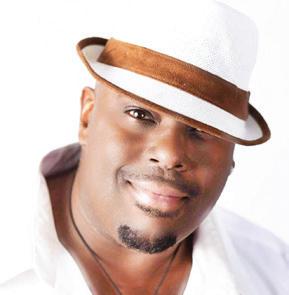


Metro Transit helped me go from three jobs to one
tomer service part came naturally. “I love people and want to do good for the com munity,” Williams said. “It’s one of the best jobs you can have.”

The first few years he worked part-time until he was able to move into a full-time role in 1996—when he decided to stop working any other job outside of transit.
“Those first few years felt like an eternity as I waited to go full-time,” he said. “Now operators can go full-time right away.”
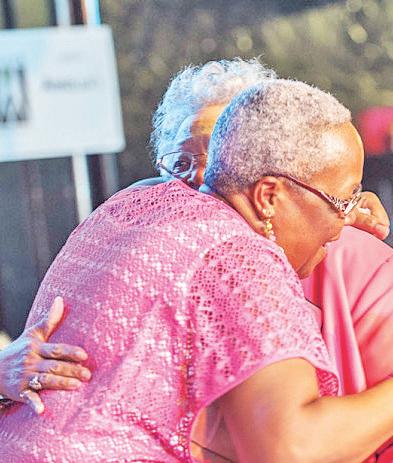


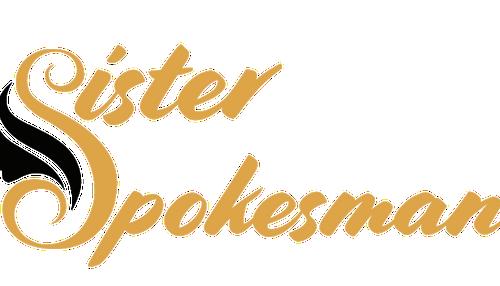
And as he approaches retirement, he’s amazed at how quickly time flew by after settling into his role. “Thirty years went by quickly,” Williams said. “I’m so glad I’m here. It really doesn’t seem so long ago that I just started!”
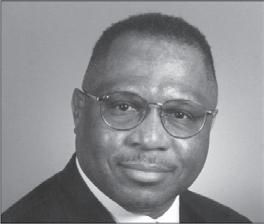
Ron Williams wishes he would have ap plied to Metro Transit earlier. “My dad told me to apply in 1987 when I was working multiple jobs,” Williams said. “It’s a stable job with great pay and benefits.”
He waited to apply because he still had a few tickets on his driving record and con tinued working two to three jobs, including driving cab and shining shoes. He joined transit as a part-time bus operator in 1992, and today, he celebrates 25 consecutive years of safe driving at transit.


“At first, I was scared of driving the bus, it was like driving a whole room,” he said. “I overcame my fear with experience and great training. Now it’s second nature.”
Operating a bus is what he says he need ed to focus on and learn because the cus




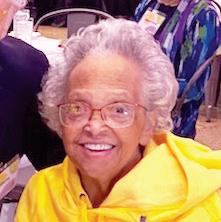

Full-
and



part-time bus operator positions available!

Metro Transit needs bus operators! No experience is required to start a new career as a Metro Transit bus operator. Receive paid training and earn a commercial driver’s license for free. Earn $26.16 per hour to start, then $27.80 after completing a year of employment.
Metro Transit provides outstanding ben efits, including health care, annual salary increases, pension plan, and an unlimitedride transit pass. Plus, there’s growth op portunities. Many managers started their careers as bus drivers.
Learn more or apply online at metrotransit.org/drive.
8 November 24 - 30, 2022 spokesman-recorder.com MINNESOT A SP OK ESMAN-R ECORDE R 3744 4th Ave. Sout h Minneapolis, MN 5540 9 Ph one : 612- 827- 40 21 Fax: 612 827- 0577 TRA CE Y WIL LI AM S -D IL LARD Pu blishe r/CE O CECIL E NEWMA N Fo u nder- Pu blishe r 1934 -1976 WALLA CE (JACK) JACKM AN Co -P ublisher Emeritu s L AUNA Q NEWMA N CE O/Pu blishe r 1976 -200 0 NOR MA JEA N WIL LI AM S Vice Pr esiden t Emeritus MEMBER ASSOCIATIONS Minnesota Newspaper Association • National Newspaper Publishers Association The Minnesota Spokesman-Recorder assumes no responsibility for unsolicited materials. Publications are published every Thursday by the Spokesman-Recorder Publishing Co., Inc. Editorial/Business o ce is at 3744 Fourth Avenue South, Minneapolis, MN 55409 SUBSCRIPTION RATES: In-state: 1 yr: $40, 2 yr: $70 Outside Minnesota: 1yr: $50, 2 yr: $90 All subscriptions payable in advance. INDEPENDENT NEWSPAPER IN PRINT & ONLINE! CALL 612-827-4021 P.O. Box 8558 • Minneapolis, MN 55408 Follow Us! @MNSpokesmanRecorder Bethesda Baptist Church Rev. Arthur Agnew, Pastor At the Old Landmark 1118 So. 8th Street Mpls., MN 55404 612-332-5904 www.bethesdamnonline.com email:bethesdamn@prodigy.net Service Times: Early Morning Service 9 am Sunday School 10 am Sunday Worship 11:30 am Wednesday Prayer Meeting, 6 pm Adult Bible Class 7 pm Children's Bible Class 7 pm Mount Olivet Missionary Baptist Church Rev. James C. Thomas, Pastor 451 West Central St. Paul, MN 55103 651-227-4444 Church School 9:30 am Morning Worship 8 & 10:45 am Prayer Service: Wednesday 7 pm "Welcome to Mt. Olivet Baptist Church" Greater Friendship M issionary Baptist Church Dr. B.C. Russell, Pastor 2600 E. 38th Street. Mpls., MN 55408 612-827-7928 fax: 612-827-3587 website: www.greatfriend.org email: info@greatfriend.org Sunday Church School: 8:30 am Sunday Worship: 9:30 am “ Winning the World with Love” Grace Temple Deliverance Center Dr. Willa Lee Grant Battle, Pastor 1908 Fourth Ave. So. Mpls., MN 24 Hour Dial-A-Prayer: 612-870-4695 www.gtdci.org Sunday School 9:30 am Sunday Worship 11:30 am Prayer Daily 7 pm Evangelistic Service: Wednesday & Friday 8 pm Pilgrim Baptist Church Rev. Doctor Charles Gill 732 W. Central Ave., St. Paul, MN 55104 Sunday Worship Service: 9:45 AM Sunday School: 8:45 AM Advertise your weekly service, directory or listing! CALL 612-827-4021 East Side Neighborhood Services 1700 NE 2nd Street, Minneapolis, MN 55413 (PLEASE USE BACK DOOR. Plenty of off-street parking!) For more information call 612.827.4021 • Find us at www.spokesman-recorder.com @sisterspokesman The afternoon includes shopping with local vendors, networking, games, elite prize tickets, food, music by KMOJ’s DJ Walter “Q-Bear” Banks and live performances by Ray Covington. The first 50 mothers to arrive will receive a gift! Men are welcome to attend! Saturday, December 3 • 12-4 pm Join us in celebration of this year’s lineup of phenomenal mothers! RayCovington
CONTENT
Loving
SPONSORED
FROM In
Memory
In loving memory of my little sister Angelica D’andrae Gaston who passed away on November 20, 2022.
Until we meet again. I love you. Your BIG brother Anthony.
Sunrise, August 2, 2000—Sunset, November 20, 2022 SUBSCRIBE TODAY Go to: spokesman-recorder.com, call 612-827-4021, or scan the code. Senior Editor Jerry Freeman Digital Editor Paige Elliott Desktop Publishers Kobie Conrath Jim Handrigan Executive Sales Assistant Laura Poehlman Administrative Office Support Cynthia Rodgers Account Representatives Cecilia Viel Ray Seville Event Coordinator Jennifer Jackmon Sports Writers Charles Hallman Dr. Mitchell P. McDonald Contributing Writers Al Brown Dr. Charles Crutchfield, III Charles Hallman Robin James Tiffany Johnson Tony Kiene Nikki Love Cole Miska Abdi Mohamed Henry Pan Angela Rose Myers James L. Stroud Jr. Contributing Photographers Steve Floyd Chris Juhn Travis Lee James L. Stroud Jr.
Employment & Legals
Software Engineer
Priscilla A. Stallings named state’s chief inclusion officer
Minnesota Management and Bud get (MMB) Commissioner Jim Schow alter announced last week that Priscilla A. Stallings has been selected as chief inclusion officer for Minnesota state government.
Stallings will lead the state’s Office of Inclusion, which focuses on issues of race, equity, and inclusion in the state workforce. She will also oversee the Governor’s One Minnesota Council on Diversity, Inclusion and Equity and the Governor’s Community Council on In clusion and Equity to develop a strate gic vision for statewide equity, diversity and inclusion initiatives and programs.
She will work closely with the gov ernor’s chief equity officer and deputy chief of staff for public engagement to coordinate with external stakeholders and community partners to identify gaps and needs and to set goals and priorities.
“Priscilla has considerable experience advancing equity and inclusion in the workforce, particularly in the public sector,” said Schowalter. “In her new role, Priscilla will work to integrate equi ty and inclusion into all aspects of Min nesota state government with the help of public councils and state agencies.”
“I look forward to working with Pris cilla to strengthen diversity, equity and inclusion efforts throughout the exec utive branch of state government,” said Erin Campbell, deputy commissioner of enterprise employee relations at MMB.
Highway, on Dec. 1 at 6 pm.
“We want to make Minnesota state government an employer of choice for everyone, regardless of race, gender identity or sexual orientation, and to provide an inclusive, welcoming en vironment for those who choose ca reers in public service.”
Previously, Stallings worked as a racial equity consultant for the Center of Economic Inclusion. Prior to that, she served as the Ramsey County At torney’s Office’s assistant director for equity, leadership, and organizational development.
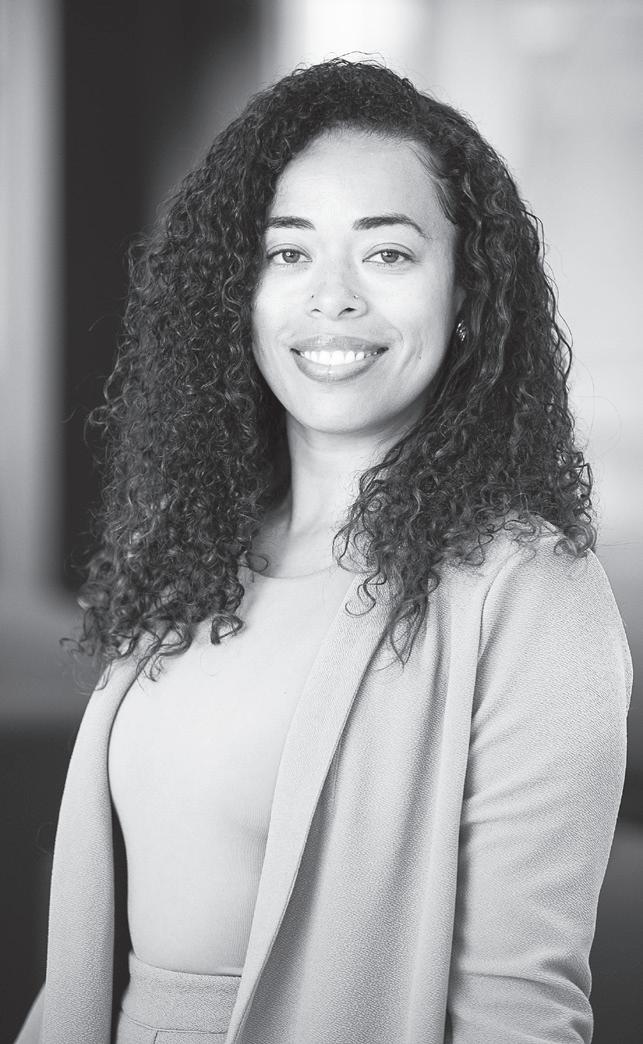
“As a long-standing staunch support er of public service who is deeply com mitted to advancing equity and inclu sion throughout our communities, I’m excited to join the State of Minnesota to drive transformational efforts to align vision with action,” Stallings said.
Stallings holds a master’s in Organi zational Leadership – Strategic Manage ment from Saint Catherine University, a dispute resolution graduate certificate from Mitchell Hamline Law School and a bachelor’s in sociology – law from the University of Minnesota.
Source: Minnesota Management and Budget
Medtronic, Inc., in Fridley, MN. Req. Bachelor’s degree in Software Engr., Computer Engr., Electrical & Electronics Engr., or rel. engr. field & 2 yrs. exp. in software engr. Exp. must incl. 2 yrs. of each of the following: Agile software dev. & structured waterfall methodologies; Agile Application Lifecycle Mgmt.; Object Oriented Design, layered architec ture, & Design Patterns; Android Studio and Intellij; Testing tools to include Mockito, Espresso, Appium, Selenium, Kata lon, & UI Automator; C++, Java, Groovy, & Kotlin; Android SDK, & UI design principles & patterns; Gherkin; & Jenkins.
To apply, visit: https://jobs.medtronic.com/, select Req. #22000O4E.
No agencies or phone calls please.
Medtronic is an equal opportunity employer committed to cultural diversity in the workplace. All individuals are encouraged to apply.
Public Notice

Community Action Partnership of Ramsey & Washington Counties is soliciting a Call for Contractors for Mechanical work and Weath erization work for the Weatherization Assistant Program.
Contracts can be requested from Elizabeth Rudebusch at 651-444-5123 or erudebusch@caprw.org.

CAPRW encourages all minority/women-owned business enterprises to apply. The Call for Con tractors will remain open to the public so long as work is needed.
potential barriers in our recruit ment process,” said Wolf at the committee meeting, adding that they attended cultural events, hosted twice-monthly hiring events, scrapped high school diploma and GED re quirements to apply, as well as increased wages to $26.16 an hour with up to a $5,000 signing bonus after the drivers’ union agreed in October.
Move Minnesota wants the agency to do more so rid ers and drivers can bear the cuts. They want the agency to demand permission from lo cal communities to implement transit-only lanes and technol ogy to give buses instant green lights so their buses don’t get stuck in traffic. The organiza tion plans to rally for its cause outside of Metro Transit’s headquarters, located at 7th Street and Olson Memorial
ReeVe
largely been as a result of the economics of the league.
We’re mindful of revenues and expenses, whereas in men’s sports it doesn’t matter if you don’t make a profit each year. As we make our way economically and our valua tion changes, which I see hap pening in the next five years, then maybe things will mirror a little bit more closely what happens on the NBA side.
CH – Some were wonder
“We have…[asked] Metro Transit to employ more of the tools [such as transit-only lanes and priority green lights for buses]…to counteract the cuts that are happening be cause of this driver shortage,” said Rockwell. “Continuing to see these cuts and not make these other improvements is not acceptable.”
The D Line, a rapid bus route similar to the A and C Lines, which will begin ser vice on Dec. 3, will operate on transit lanes and green light technology. But it comes with cuts to Route 5 and 721.
The 5 will only run once an hour and only between Brooklyn Center Transit Cen ter and Chicago and 56th St., while the 721D branch, which operates between Brooklyn Center Transit Cen ter to downtown Minneapo lis on I-94 and Dowling Av enues, will be eliminated.
Other changes the agency
ing why it took so long for you to re-up with the Lynx organi zation.
CR – This process started in February. By the time we got to April, it was too close to the season for me at the time. I just tabled it for the season. I just figured that we wouldn’t be able to get some thing done [until] following this season.
Then I really needed to hear from Marc [Lore] and Alex [Rodriguez, the team’s incoming majority owners]. I think there was just more of an investigative period, taking
plans to make include restoring direct service from New Brigh ton to downtown Minneapolis for the first time since August 2021 by creating a new Route 25 branch. They will also move Routes 4, 6, 7, 14 and 61 back to Hennepin Ave. after Min neapolis wrapped up construc tion in September.
The agency posted sched ules on its website on Nov. 3. Metro Transit expects to begin distributing paper schedules at customer service centers and public buildings later this month. They plan to distrib ute paper schedules on their buses again sometime next year, once they have a vendor to print and store them.
Sean Rogers of St. Louis Park, who rides the Route 30 to his job in Northeast Min neapolis, was also unaware of the cuts, which would re sult in the 30 running once an hour at certain times of the day. Rogers wishes the agency would resume dis

stock of the whole situation. The five-year period is pretty lengthy, and I just wanted to make sure that was the right way for me.
CH – It’s been almost two years since the pandemic af fected sports. How much has the WNBA recovered since fans returned in 2021?
CR – We had some mo mentum right before the pan demic, and then the pandemic hits. How do we still maintain this momentum that we had? [Now] there’s just a lot of ex citement that you can feel, it’s palpable. And when expan
tributing schedules on the buses again so they know of the changes ahead of time. “You never know if you have a phone with wifi,” said Rogers as he rode the 30 to work.
The following routes will be affected by service cuts beginning Dec. 3: Orange Line, 4, 5, 6, 7, 9, 23, 25, 30, 46, 61, 62, 64, 65, 67, 83, 87, 94, 115, 219, 264, 270, 275, 294, 323, 363, 534, 537, 538, 540, 542, 546, 547, 645, 667, 673, 721, 755, 760, 766, 804, 805, 824, 852. To view a full list of cuts Metro Transit plans to make on Dec. 3, visit bit.ly/MetroTransitPlans.
Those interested in con necting with Move Minnesota around lobbying for transit should contact Julie Johnson at johnsonj@movemn.org.
H. Jiahong Pan welcomes reader responses to hpan@ spokesman-recorder.com.
sion happens [in a couple of years] the price that some body will pay for a team is go ing to be significant. It’s going to be very, very newsworthy. We have a TV deal on the horizon. That should be ex tremely significant for our league. Just a number of re ally, really good signs that the economics of our league are changing drastically.
CH – WNBA prioritization kicks in this upcoming sea son—all players must be in training camp when it starts or May 1, whichever is later. Players with more than three
years in the league will be fined for every day they miss and will be suspended for the entire season if they miss the start of the regular season. Do you see this as a problem with your club?
CR – I don’t see it to be a problem for a large percent age of [players]. I think overall it’ll be a positive.

CH – You and I are among many who strongly advocate for equitability in women’s sports, and especially in the WNBA in terms of media coverage among other things. Are you seeing progress in this area?


CR – Despite all the chal lenges, despite getting less than 5% of the coverage, we’re overcoming all those things. The criticism that you have is very balanced. I think as corporate sponsorships change, the way we view women in sports changes, all the money is going to come in. You’re gonna see things like [expanded] roster sizes. The number of teams will all fol low from there.
Charles Hallman welcomes reader responses to challman@ spokesman-recorder.com.
Contunued from page 10
College’s historic prowess.
Talladega College is Ala bama’s first private histori cally Black liberal arts college, founded in 1867 by formerly enslaved Blacks after the Civil War. Its campus is located in
Talladega, which is 50 miles east of Birmingham, 85 miles north of Montgomery, and 100 miles west of Atlanta, Georgia.
The school still has the original schoolhouse used for classrooms (Swayne Hall), and its library was the original home of the Amistad Murals.
“These murals are valued at $50 million,” noted Vincent.
Over the last three years, Talladega opened three new state-of-the-art facilities—a 45,000 square foot residence hall (2019), a new student ac tivity center, and a new mu seum, both in 2020. Several national publications have listed the college among the nation’s best liberal arts col leges, best HBCUs, and in
2019 rated it second among U.S. colleges for “low average graduating debt.”
Vincent, who was named school president March 31, pointed out that the college was founded on “a faith in spired mission to educate gen erations of students to come.”
Some might compare what happened to the Talladega
players to what happened back in September when a Duke Black volleyball player reported a racial incident during a game at BYU in Sep tember. The host school later concluded after its investiga tion that they couldn’t find any evidence of wrongdoing.
“I think the big difference is that this is a verified in
cident,” said Vincent. “This racist image was dropped to one of our players and others received it.” He considered it a no-brainer to support the players’ protest because it “sends a message.”
November 24 - 30, 2022 9
Charles Hallman welcomes reader responses to challman@ spokesman-recorder.com.
View
Contunued from page 10
Priscilla A. Stallings Courtesy of MMB
TRansiT Contunued from page 2 call 612.827.4021 Find us at @sisterspokesman FOR MORE INFORMATION
Lynx HC Reeve optimistic on league prospects
By Charles Hallman Sports Columnist

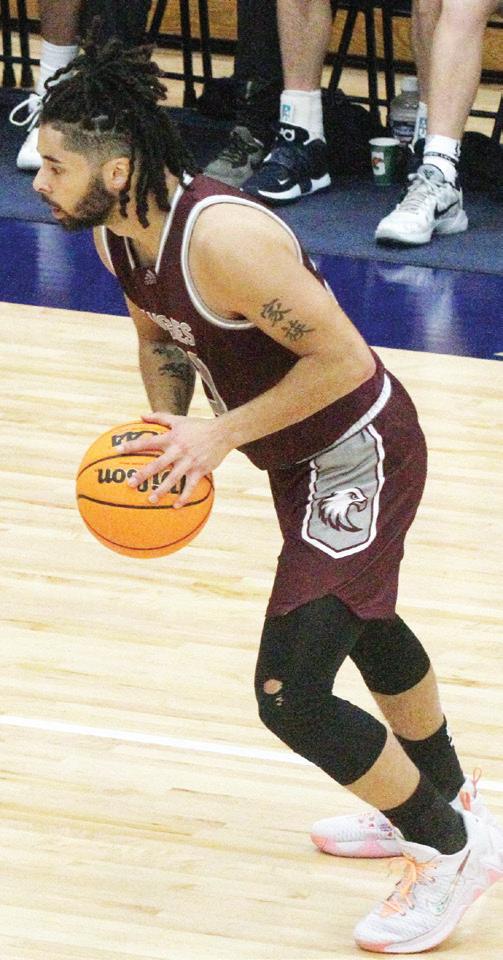
he Minnesota Lynx will have the second over all pick in the 2023 WNBA Draft. Cheryl Reeve, who signed a new five-year contract, is now president of basketball operations as well as head coach. Reeve (CR) recent ly talked to the team’s longest tenured beat writer Charles Hallman (CH) about her new job and other pertinent topics.

CR
CH –
CR – The NBA is far more extensive in salary cap and they don’t have a hard cap. I just know that in our league it has




■ See Reeve on page 9

he Talladega (Ala.) Col lege volleyball team ended its 2022 season on a very sour note. Besides a three-match losing skid, the Tornadoes (13-17, 5-13 South ern States Athletic Conference (SSAC) left its league tourna ment earlier this month after a player received a racial image on social media.

According to the school re lease, the team walked out of the SSAC awards banquet in protest “due to what the in stitution believes to be a lack of action taken around racial abuse.” ESPN and the Associ ated Press reported the team walkout last week and that the SSAC, which is in the NAIA, was still investigating the in cident

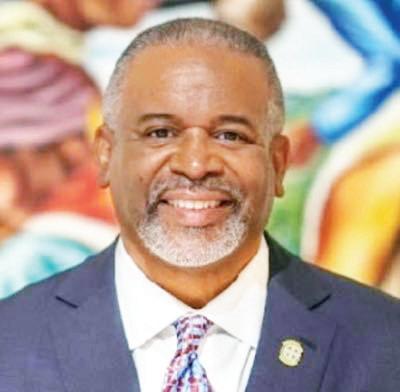
“The commissioner ad
Fab Five Pics of the Week
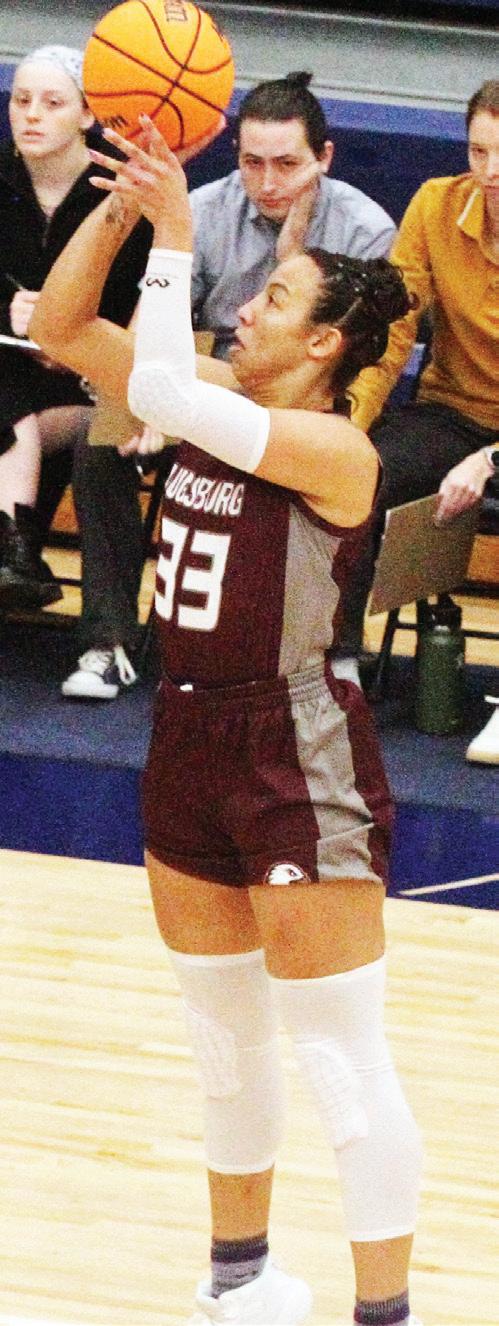
his week’s “Fab Five Pics” feature: a Blake School alum who helped the Macalester College men’s bas ketball team defeat Augsburg University 72-53 in their MIAC season opener (Robert Grace); a teammate that scored 14 points (Badou Ba); a former Eastview High School star who represent ed Augsburg in the same contest (Caden Scales); a junior center who scored 10 points in lead ing Augsburg to a 49-39 MIAC women’s basketball victory over Macalester (Anja Smith); and a player who scored 10 points for Macalester in the same game (Peyton Starks).
Dr. Mitchell Palmer McDon ald welcomes reader responses to mcdeezy05@gmail.com.
Racial incident in volleyball leads to players’ walkout
dressed it immediately,” said Talladega President Gregory J. Vincent last week in an exclu sive interview with the MSR. He was not quoted in both mainstream media accounts, which used excerpts from the released statement from the school and did quote SSAC Commissioner Mike Hall, who said the league was still inves tigating the incident.
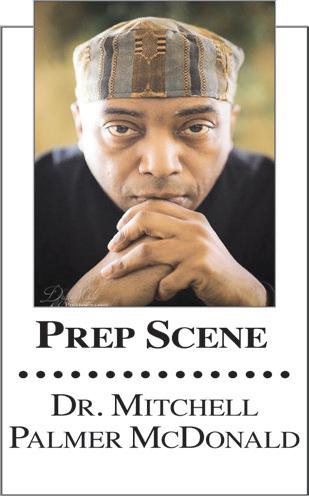
Vincent said that once the player received the racial im age, she reported it to her
coach. The school in turn re ported it to SSAC officials prior to the tournament. However, it was something Hall said dur ing his banquet remarks that
didn’t sit well with the Talla dega players, which convinced them to walk out of the tour ney and concluded its season.
“I think he used some lan guage that I think could have been reframed,” continued Vincent. “He [said], ‘They are part of us,’ as if we’re not part of them. I would have wished he would have used some dif ferent language. He kind of danced around [the racist inci
dent]. He also didn’t explicitly call it racist.
“I give him credit for ad dressing it quickly. I think [with] a little more time we could have addressed that in a more complete way.”
Briefly, the unfortunate racial incident and the player walkout got the mainstream media attention rather than shining a spotlight on Talladega
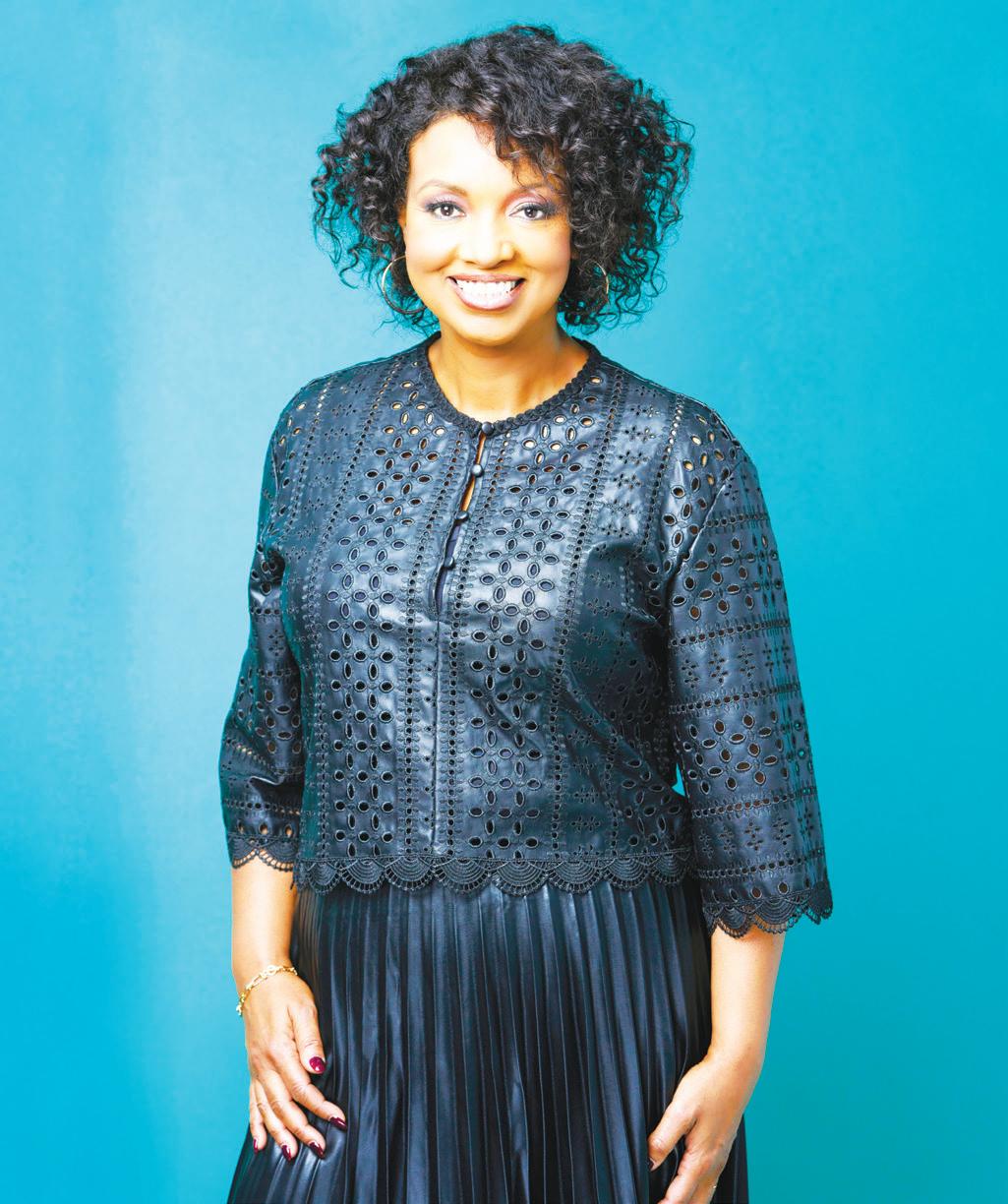
Sports among wide-ranging topics in new Black collection
t didn’t make Time’s recent “100 Must-Read Books of 2022,” but BLACKTOLD (Andscape Books, October), a collection of Black essays, deserves more than an honor able mention on any book list.
The 33 essays all written by Blacks, edited by Steve Reiss, the executive editor at And scape (formerly The Undefeat
Morrison changed her life is one of nearly three dozen divided into four categories: Black Lives Matter (6), Ameri can History (7), Arts & Culture (12) and Sports (8). Among the writers featured are Wil liam C. Rhoden (2), Justin Tinsley (2), and Dwayne Bray (2) addressing subjects that range from Black culture pre-
ed), with “an urgent foreword” by Editor-In-Chief Raina Kelley, is according to its press kit, “a multi-purpose map, serving as a guide through a time when the truth is stranger than fiction.”
“I am writing this foreword to make a point—or rather to put forward a different point than one normally makes in a foreword,” wrote Kelley. “This book is the harbinger of and a balm for a world transformed.”
Kelley’s essay on how Toni
George Floyd to the racial reckoning America saw after Floyd’s 2020 death in Min neapolis.
“I think the first thing that I want people to take away is that this is not a hopeless cause,” said Kelley in an MSR phone interview. She was in Paris, France en route to a ra cial justice conference in Ger many.
The BLACKTOLD essays document Black life from all
a
angles, told
lens, noted Kelley—”what had
that
we covered in real time. There were so many great pieces that we could have put in and we just couldn’t. We couldn’t fit them all in.”
A book two, perhaps?
“It’s about understanding ourselves, if anything, without the White Gaze,” she contin ued. “There is a shared lan guage amongst Black people here in America and across the diaspora that focuses on a point of view that’s not neces sarily about [Black] leaders or White viewers.”
Kelley assumed her cur rent role as Andscape vicepresident and editor-in-chief in May 2021, succeeding its founding editor Kevin Merida, who launched The Undefeat ed in May 2016. Before that, she was managing editor and instrumental in its growth.
“It’s been a crazy time,” said Kelley of the name change in February. She wrote at the time, “We do a lot now. But we
want to do more and we need a name that can grow with us. AND is for the infinite ways we define Blackness, and SCAPE is for an inclusive, eclectic, and deeply dimensional view of the world.”
BLACKTOLD is just the be ginning, Kelley pointed out. “We have a number of books coming out next year. One is the mem oir of (former Minnesota Lynx) Maya Moore and Jonathon Irons. And an album coming out in February. And you should see a couple of things from Andscape Studios on your local streaming network.”
Andscape will “continue and grow our digital pres ence which we have as a conduit to bring more Black viewers to the Walt Disney Company,” who owns it, con cluded Kelley.
10 November 24 - 30, 2022 spokesman-recorder.com Sports
Cheryl Reeve
Courtesy of the MN Lynx
“I think the big difference is that this is a verified incident.”
See View on page 9
Talladega President Gregory J. Vincent Courtesy of Twitter
■
CH – Explain your new job.
– I can be more focused on the bigger picture, because the last couple years of having the general manager [duties] during the season were really difficult.
How challenging is hold ing a dual role in the WNBA com pared to the NBA?
“There are a number of really, really good signs that the economics of our league are changing drastically.”
Caden Scales, a junior guard for Augsburg University, dur ing a MIAC men’s basketball game against Macalester Col lege Saturday, November 19 in Saint Paul.
Macalester College sopho more guard Robert Grace dur ing a MIAC men’s basketball game against Augsburg Uni versity Saturday, November 19 in Saint Paul.
Macalester College sopho more forward Badou Ba dur ing a MIAC men’s basketball game against Augsburg Uni versity Saturday, November 19 in Saint Paul.
Augsburg University ju nior center Anja Smith during a MIAC women’s basketball game against Macalester Col lege Saturday, November 19 in Saint Paul.
Peyton Starks, a junior guard for Macalester College, during a MIAC women’s bas ketball game Saturday, No vember 19 in Saint Paul.
through
Black
happened over the last six years, those moments
All photos by Dr. Mitchell Palmer McDonald
“It’s about understanding ourselves without the White Gaze.”
Raina Kelley
Courtesy of Andscape
Charles Hallman welcomes reader responses to challman@ spokesman-recorder.com.































































